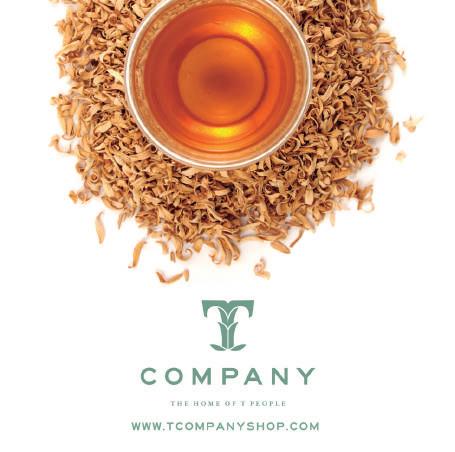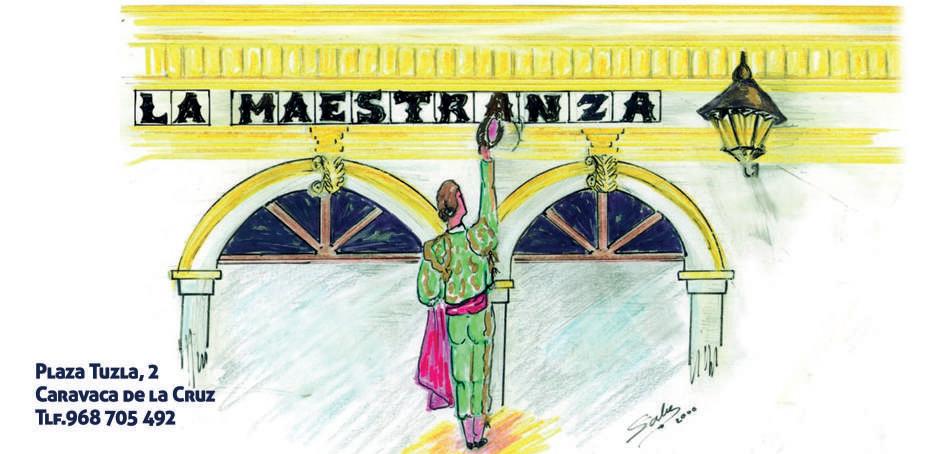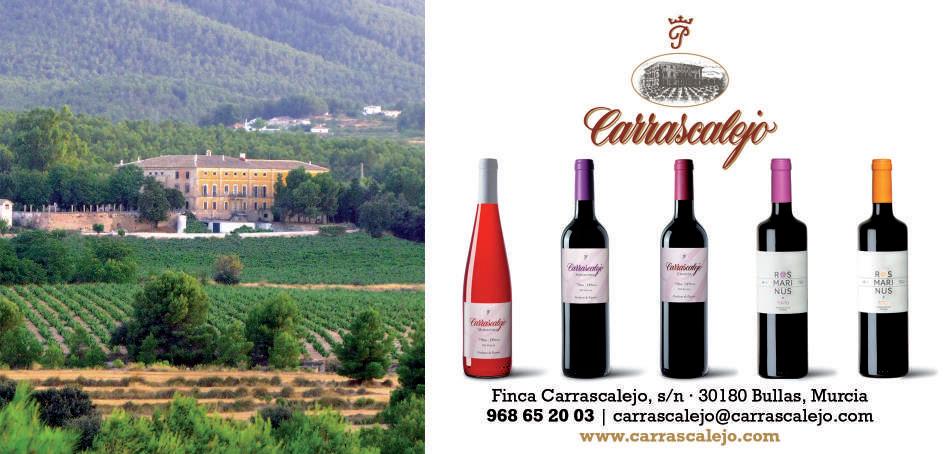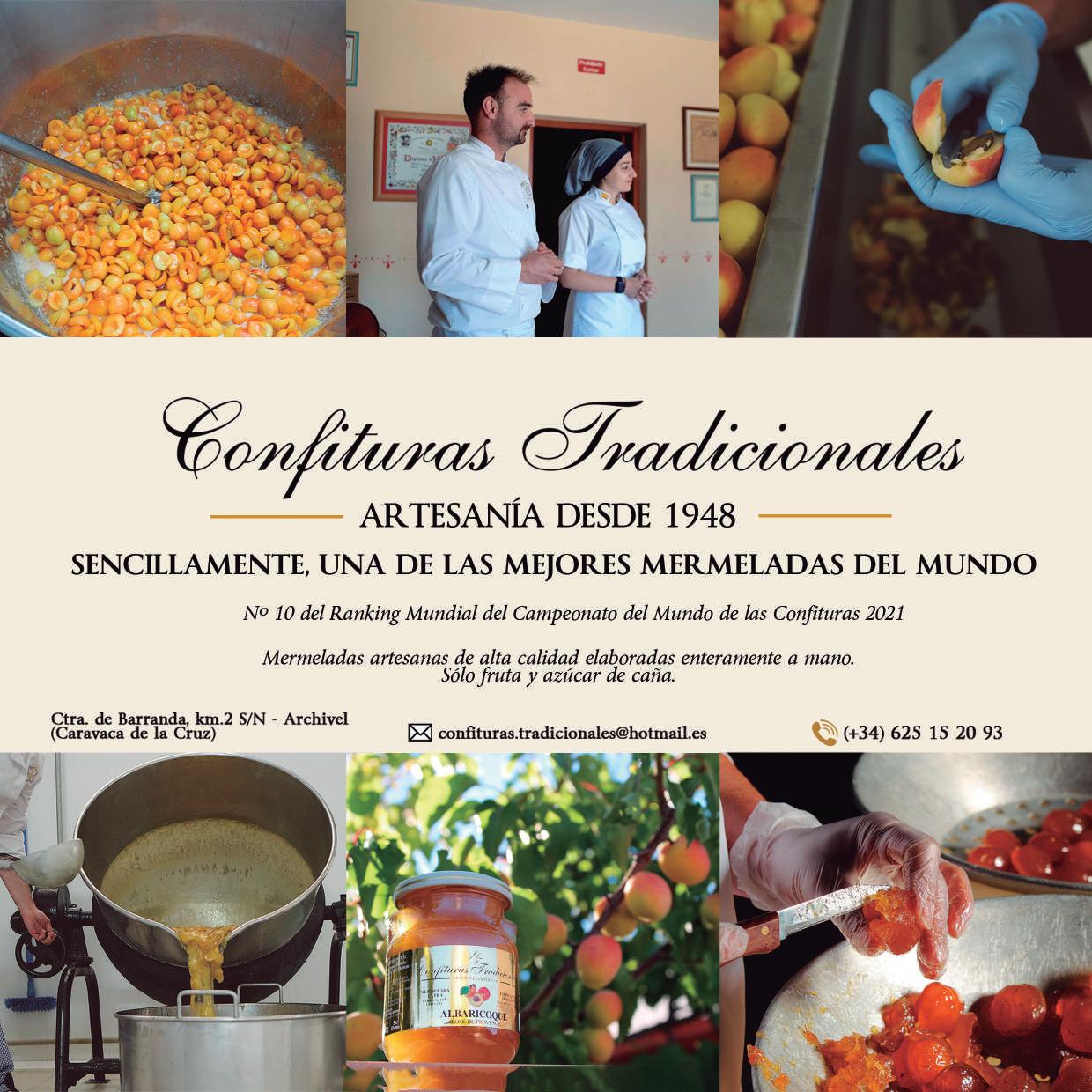CARAVACA DE LA CRUZ



 MURCIA • SPAIN
MURCIA • SPAIN





 MURCIA • SPAIN
MURCIA • SPAIN

Caravaca de la Cruz, municipio que supera los 26 000 habitantes y con una extensión de 859,51 km2, es cabecera de la amplia comarca del Noroeste de la CC. AA. de la Región de Murcia y población de referencia de otros municipios de las vecinas provincias de Granada, Jaén y Albacete.
Caravaca de la Cruz está situada a 625 m de altitud sobre el nivel del mar y posee un clima mediterráneo algo continentalizado con veranos secos en los que se dan temperaturas oscilantes entre moderadas y calurosas, inviernos fríos y primaveras suaves y lluviosas; la tempe -
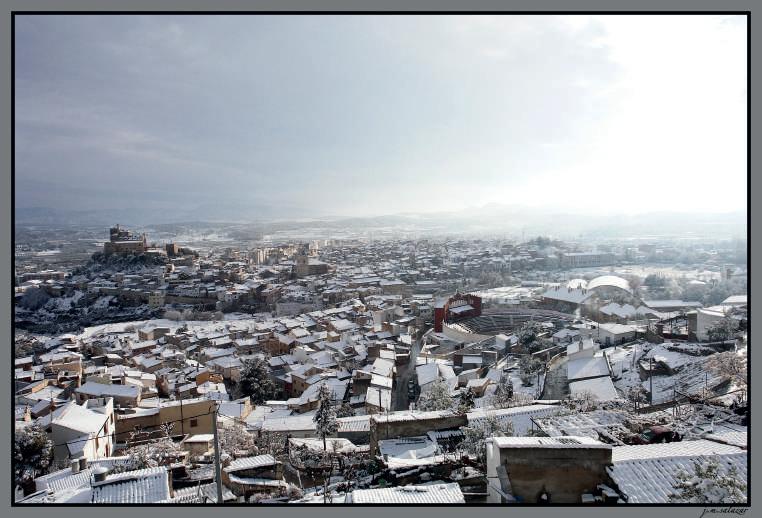
ratura media es de 15,4 °C con una oscilación térmica de 12 °C. El municipio presenta en su conjunto una altitud elevada, ya que cerca de dos tercios de su territorio se sitúan por encima de los 800 m al norte y al oeste del término se encuentran los núcleos montañosos más elevados: Sierra de Mojantes (1605 m) y Sierra del Gavilán (1477 m).
Atravesada por los ríos Argos y Quípar que recorren el municipio en dirección oeste-este, es zona rica en recursos agropecuarios, lo que ya desde antiguo permitió que se convirtiera en lugar de asentamiento de diversos pueblos.
Caravaca de la Cruz is a district of more than 26,000 inhabitants covering an area of 859,51 km2 (approx 332 sq mi). It is the main city on the northwest area of the Region of Murcia and a reference point for many municipalities in the neighbouring provinces of Granada, Jaén and Albacete.
Caravaca de la Cruz is located at an altitude of 625 metres above sea level. It has a mediterranean climate, with some continental characteristics. Temperatures can vary from moderate to warm during dry summer. It has cold winters and soft and rainy springs. Annual average temperature
is 60 °F (15, 4 °C) and the difference between maximum and minimum temperatures is 53.6 °F (12 °C). District average temperature is high. Almost two third parts of the area are located at 800 meters above sea level. Sierra de Mojantes (1605 m) and Sierra del Gavilán (1477 m), on the north area and the west area of the district, are the highest mountain ranges.
Argos River and Quípar River pass through the district from west to east, what makes it rich in agricultural resources. This situation has made the area a suitable place for village settlements from ancient times.
En lo que hoy constituye su término municipal, encontramos en el Paleolítico los primeros vestigios de poblamiento. A partir de ese momento otras culturas se van a asentar en estas tierras como atestiguan los yacimientos neolíticos, argáricos, íberos y romanos encontrados.
Es en el período medieval cuando se configura el primitivo trazado urbanístico de la villa que se limitaba al Cerro del Castillo. Es también en dicho período donde se sitúa la llegada de la Cruz a Caravaca. Pero será la conquista del Reino de Granada lo que supondrá para esta zona un notable auge económico, social y demográfico.
Sin embargo, no puede hablarse de Caravaca como núcleo urbano hasta bien entrada la Edad Media, es decir, hasta la época de dominio musulmán. En excavaciones llevadas a cabo en el Santuario se encontraron materiales cerámicos que demuestran la existencia de un establecimiento romano entre los siglos I y IV d. C.

A esto sigue un período de tiempo sin referencia poblacional que se prolonga hasta el siglo XII con la aparición de restos cerámicos. La práctica inexistencia de textos de los primeros siglos de dominio musulmán es indicio de su escasa importancia como núcleo urbano; Al-Himyari hace referencia a la Caravaca del siglo XI como a una alquería o aldea perteneciente al distrito de Mula. La necesidad de protección de este pequeño núcleo poblacional le llevó a levantar en lo alto de la colina donde hoy se alza la Basílica-Santuario, una rudimentaria fortificación que fuera amparo de personas y animales. En las postrimerías del dominio musulmán la situación de aislamiento del reino taifa de Murcia obliga a su rey, Muhammad Ibn Hud, a ofrecer vasallaje al rey de Castilla, Fernando III, solicitando el protectorado sobre Murcia. Así mismo,
en 1243 se firma la Capitulación de Alcaraz y el 1o de mayo de ese año el entonces infante D. Alfonso (que más tarde habría de ser conocido como “El Sabio”), toma posesión en nombre de Castilla de casi todo el reino, incluida Caravaca. En el mes de julio de ese mismo año el catalán Berenguer de Entenza toma posesión de la villa. Unos años después, en 1266, Caravaca, Cehegín y Bullas son entregadas a la Orden del Temple. Tras la desaparición de ésta, será la Orden de Santiago la que se haga cargo de ella, primero, de hecho, y más tarde de derecho cuando allá por 1344, por un privilegio fechado en Toro el 3 de agosto de dicho año, el rey Alfonso XI conceda a su hijo bastardo Don Fadrique, a la sazón maestre de la Orden de Santiago, las villas y lugares de Caravaca, Cehegín y Bullas.
Con la toma de Granada por los Reyes Católicos se inicia realmente el desarrollo de la villa como tal. El punto álgido de su crecimiento político y económico se alcanzará a lo largo del siglo XVIII favorecida, en gran medida, por la exportación de cereales y cáñamo. A comienzos del siglo XIX se cifran sus recursos económicos en los montes de pino, así como en el esparto, la producción de cereales, lino, aceite, legumbres, frutas y hortalizas, cáñamo, en el ganado lanar y caprino y en las industrias de jabón, paño, lienzo y aguardiente.
El 26 de julio de 1849, la Reina Isabel II concede a Caravaca el título de la ciudad.
Hoy Caravaca de la Cruz es una ciudad moderna, fundamentalmente de servicios, que cuenta con amplios equipamientos de todo tipo: sanitarios, educativos, comerciales... y una moderna autovía que la comunica con Murcia en menos de una hora, todo lo cual, unido a las actividades agropecuarias y al sector industrial, la convierten en una población dinámica y emprendedora.
Fachada Basílica.First settlements of today’s municipal area of Caravaca de la Cruz remain to Palaeolithic period. From that moment on, other cultures began to settle on these lands, as vouched for the Neolithic, Agar, Iberian and Roman sites found.
The castle’s hill delimited the primitive urban layout of the village on the medieval period. It is also in this period that the Cross is thought to have reached Caravaca. But it was the conquest of the Kingdom of Granada that brought significant economic, social and demographic growth for Caravaca.
However, Caravaca cannot be considered as an urban area until Middle Ages, which corresponds to Muslim domination period. Ceramic materials found in the excavations carried out in the Sanctuary make proof of the existence of a roman setting in between the 1st and the 4th centuries AD.
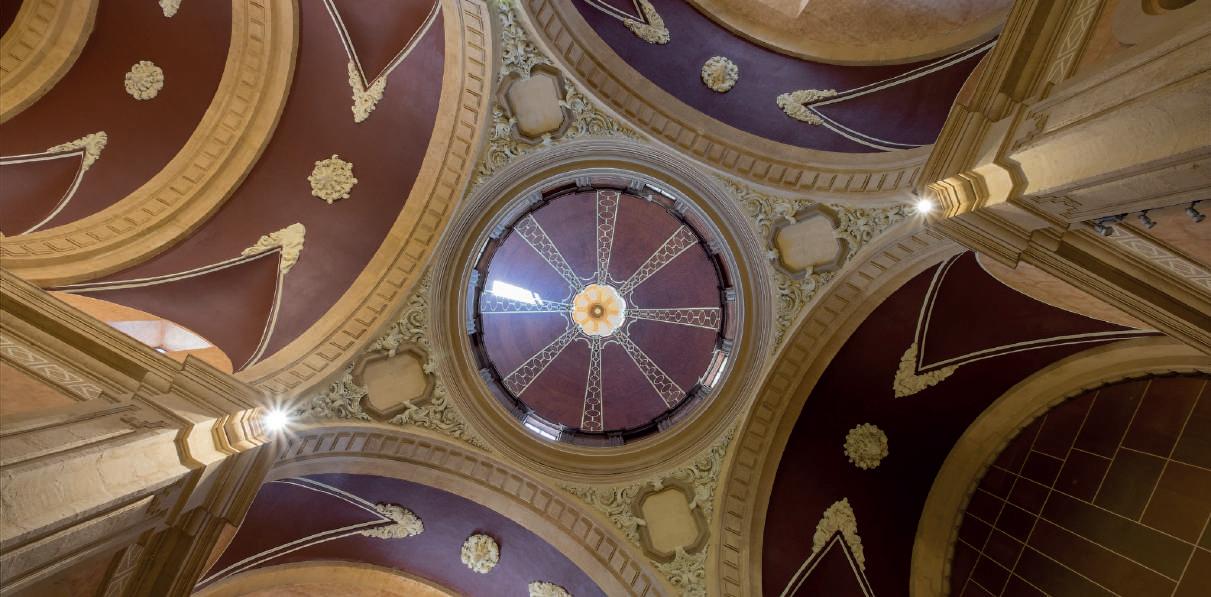
This was followed by a period of time that does not have any population information recorded and that lasted until the 12th century, when some ceramic remains were found. The almost total inexistence of texts from the first centuries of Muslim control indicates that this urban area did not have a high significance at that time; Al-Himyari refers to 11th-century Caravaca as a small village belonging to Mula’s district. The need to protect this small urban area led to the construction of a rudimentary fortification. This fortification situated at the top of the hill, where the Basilica-Sanctuary stands today, provided shelter for people and animals. At the end of Muslim domination period, the isolation of the Taifa Kingdom of Murcia forced Muslim King, Mohammed Ibn Hud, to offer its vassalage to Fernando III (Ferdinand III), King of Castile, requesting a protectorate over Murcia. The Ca-
pitulation of Alcaraz (“Capitulación de Alcaraz”) was signed in 1243 and on the 1st of May of that year, Prince Alfonso (later know as “Alfonso The Wise” or “Alfonso El Sabio”) took possession of almost the whole kingdom, including Caravaca, in the name of Castile. In July that year, the Catalan Berenguer de Entenza took possession of the village. A few years later, in 1266, Caravaca, Cehegín and Bullas were handed over the Order of the Temple. The Order of Santiago took control of the village when this Order disappeared. It did it first in fact and later in right when, in around 1344, through a privilege dated in Toro on August 3rd that year, King Alfonso XI granted the towns and places of Caravaca, Cehegín and Bullas to his bastard son Fadrique, Grand Master of the Order of Santiago.
The real development of the village started when Granada was taken by Catholic Kings. The highest
point of this political and economic growth was reached in the 18th century, largely favoured by cereal and hemp exports. At the beginning of the 19th century, its economic resources were calculated as lying in the pine mountains as well as in esparto grass, the production of cereals, flax, oil, legumes, fruits and vegetables, hemp, sheeps and goats and in the soap, cloth, canvas and liquor industries.
The July 26 of 1849 the Queen Elizabeth II, gave Caravaca the tittle of city.
Nowadays, Caravaca de la Cruz is a modern, services-driven city with a wealth of facilities of all types: health, education, commercial, among othersIt also has a modern highway that connects it with Murcia in less than one hour, all of which, together with its farming activities and industrial sector, make it a dynamic and enterprising town.
La Stma. y Vera Cruz de Caravaca es una cruz de origen oriental y aspecto patriarcal, por tanto, de doble travesaño o cuatro brazos. Se cree que perteneció al patriarca Roberto de Jerusalén, que fue el primer obispo de dicha ciudad una vez conquistada a los musulmanes en la primera cruzada. En Caravaca de la Cruz se venera desde el siglo XIII, concretamente en torno al año 1231 en que, según la tradición, se fecha el milagro de su Aparición.
La Cruz de Caravaca es un “Lignum Crucis”, es decir, un trozo de madera perteneciente al leño donde fue cru-
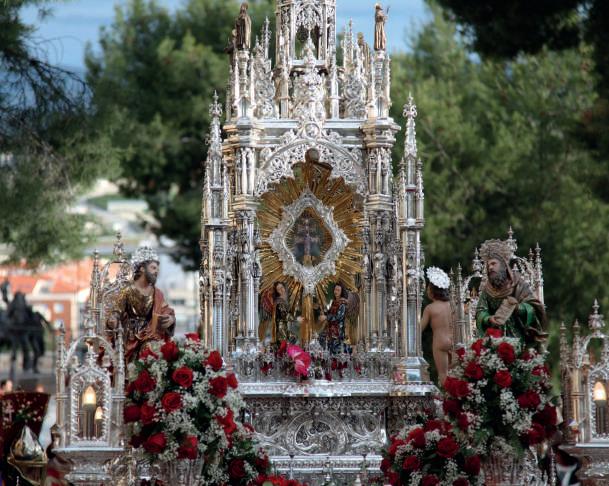
cificado Cristo, conservado en un relicario en forma de cruz de doble travesaño. Esta Cruz, desde antaño, ha sido reconocida por la Iglesia Católica como “Vera Cruz” (Verdadera Cruz), otorgándosele bulas e indulgencias a los peregrinos que iban a adorarla. Asimismo, la Iglesia le concedió en 1794 el Culto de Latría (equivalente al que recibe el Santísimo Sacramento).
La tradición nos habla de que la reliquia se apareció un 3 de mayo del año 1231, y dice así: “Las tierras caravaqueñas habían sido conquistadas por el Sayid almohade de Valencia Abu-Zeit que, en el año en que
acontece la historia, estaba instalado aquí. Se cuenta que entre los prisioneros cristianos había un sacerdote conquense llamado Ginés Pérez Chirinos. El Sayid interrogó al prisionero sobre cuál era su ocupación, a lo que éste respondió que “decir misa”. La respuesta del sacerdote suscitó la curiosidad del Sayid, el cual mandó traer todo lo necesario para que Chirinos pudiera realizar una demostración de dicho acto litúrgico en el salón principal del Alcázar. Al poco de comenzada la celebración Chirinos detúvose y expresó la imposibilidad de continuar la ceremonia por faltar en el altar un crucifijo. Y fue precisamente en tal momento cuando, por la ventana del salón, apareciéronse dos
ángeles que portaban una cruz que depositaron en el altar a fin de que el sacerdote pudiera continuar la misa. Ante aquella milagrosa aparición, cuenta la tradición, el Sayid y los suyos se convirtieron al cristianismo”.
La difusión de la Cruz de Caravaca por todo el mundo se debió a las numerosas órdenes religiosas que aquí se establecieron. Fueron sobre todo los jesuitas y los franciscanos los que, en su afán misionero, llevaron el conocimiento de la Cruz de Caravaca a toda Hispanoamérica y Europa.
The True and Holy Cross (Santísima y Vera Cruz) of Caravaca is a cross of oriental origin and patriarchal appearance, therefore a double crosspiece or four arms cross. It is believed to have belonged to the patriarch Robert of Jerusalem (Roberto de Jerusalén), who was the first bishop of Jerusalem after Muslims lost its control during the First Crusade (1099). In Caravaca de la Cruz, the Cross has been venerated since the 13th century, specifically around the year 1231 when, according to tradition, the date of the miracle of its appearance is held.
The Caravaca Cross is a “Lignum Crucis”, meaning a piece of wood that came from the timber where Christ was crucified, conserved in a reliquary with the form of a double crosspiece cross. Since ancient times, this cross has been recognised by the Catholic Church as a “Vera Cruz” (True Cross), granting papal bulls and indulgences to the pilgrims who came for the worship
of the Cross. Similarly, in 1794 the Church granted the “Culto de Latría” (equivalent to the Cult received by the Blessed Sacrament).
Tradition tells that the relic appeared on May 3rd 1231, and states that: “The lands of Caravaca had been conquered by Abu-Zeit, Almohad Sayid (Islamic Sultan) of Valencia who, according to history, was settled here in that year. It is said that, among the Christian prisoners, there was a priest from Cuenca called Ginés Pérez Chirinos. The Sayid interrogated the prisoner about his occupation, and so he replied “giving Mass”. The priest’s reply filled the Sayid with curiosity, ordering that everything required should be brought to the main hall of the Alcázar so that Chirinos could demonstrate this liturgical act. Soon after Chirinos started to speak, he stopped and said it was impossible to continue the ceremony due to the lack of a crucifix on the altar. It was right at that exact moment that, through the window of the hall, two
angels appeared, carrying a cross that they placed on the altar so that the priest could continue the Mass. Tradition says that, in the presence of this miraculous appearance, the Sayid and his followers converted to Christianity”.
The dissemination of the Cross of Caravaca all over the world was due to the numerous Religious Orders established in Caravaca. Mainly Jesuits and Franciscans, in their missionary work, spread the word of the Cross of Caravaca all over South America and Europe. La Cruz de Caravaca. Stma. y Vera Cruz de Caravaca.
En febrero de 1998 Caravaca fue privilegiada con la concesión de un Año Jubilar Perpetuo en torno a nuestra Patrona, la Stma. y Vera Cruz, en un documento expedido por el Sumo Pontífice Juan Pablo II, a través de la Penitenciaria Apostólica de la Santa Sede. La concesión de un “Año Santo” a perpetuidad, supone la celebración de un Año Jubilar cada siete años, acontecimiento que tendrá nuevamente lugar en 2024.

Entre las causas que motivaron la concesión cabe destacar un hecho religioso, cuya trascendencia se remonta a más de siete siglos en la historia de España, de la Región de Murcia y de Caravaca de la Cruz: la presencia de la Stma. y Vera Cruz en estas tierras desde el siglo XIII, cuyo origen oriental es harto comprobado y en la que la tradición religiosa y la fe cristiana considera depositadas varias astillas del “Lignum Crucis” en el que murió Jesucristo.
Este hecho ha supuesto el desarrollo, a lo largo de siete siglos, de un culto religioso enraizado en el seno de la fe cristiana y admitido por la Iglesia Católica, hasta el punto de asignársele por el Vaticano (siglo XVIII) el culto de “Latría”, equivalente al tributado al Santísimo Sacramento.
Esta realidad transcendió los estrictos límites geográficos regionales, e incluso nacionales, convirtiéndose Caravaca en un punto neurálgico y de referencia religiosa, teniendo su máximo apogeo en los siglos XVI, XVII y XVIII, épocas en las que primó el verdadero carácter religioso de la Stma. y Vera Cruz frente a otros atribuidos con posterioridad de carácter esotérico.
La fe regenerada en torno a la Santa Reliquia propició fundamentalmente en los siglos referidos, y aún con anterioridad, verdaderas corrientes de peregrinación hacia su Santuario desde los más diversos puntos de la geografía española; hasta tal punto que ya en pleno siglo XVI se hallaba establecido un Hospi-
tal en la localidad, el del Buen Suceso, con el fin fundamental de atender a los peregrinos.
Asimismo, y con la finalidad de propiciar, difundir y mantener el culto a la Vera Cruz, nació la Real e Ilustre Cofradía de la Stma. y Vera Cruz de Caravaca, cuyos orígenes documentalmente probados se remontan a la Edad Media y que, ya en el siglo XVII, estaba instituida canónicamente, con base en las constituciones de Clemente VIII y Pablo V. Como muestra del valor de las referidas peregrinaciones nos pueden servir los jubileos decretados en distintos años de los siglos XVI y XVII, con motivo de las diferentes festividades de la Cruz (mayo, julio, septiembre) o la solicitud concreta que dirigía la Cofradía en 1663 al Papa Alejandro VII, para que se pudieran admitir en la misma cofrades procedentes de distintos puntos de España (lo que fue un hecho).
Otros dos motivos pueden servir de móvil justificativo a lo que ha sido la base para la concesión eclesiástica del Año Santo. Por una parte, el hecho de que hace años, en 1981 fuese concedido un Año Jubilar a Caravaca con motivo de la celebración del 750 aniversario de la Aparición de la Vera Cruz en Caravaca y posteriormente en 1996, se concediese otro Año Jubilar que atrajo hasta la localidad a más de 700 000 peregrinos. Por otra, el deseo de clarificar, a nivel nacional, el verdadero sentido de la Vera Cruz de Caravaca, como símbolo de fe cristiana, frente a la difusión simplista y tergiversada que de ella se venía haciendo en los últimos tiempos.
Por último, la acción conjunta de varias instituciones (Ayuntamiento, Cofradía, Obispado y Comunidad Autónoma) nos lleva, ya con las experiencias anteriores, a una organización cada vez mejor y una mayor difusión del conocimiento y devoción de la Cruz, con un progresivo aumento de visitantes y un incremento del sentido religioso-crucífero de éstos.
In February 1998 Caravaca was granted the privilege of one Perpetual Jubilee Year over the True and Holy Cross, our Patron Saint, in a document issued by the Supreme Pontiff, John Paul II, through the Apostolic Penitentiary of the Holy See. The granting of a “Holy Year” in perpetuity, means celebrating a Jubilee Year every seven years. This event will take place again in 2024.
One of the most important reasons why the Perpetual Jubilee Year was granted to Caravaca is a religious event, whose significance dates back to more than eight centuries ago in the history of Spain, the Region of Murcia and Caravaca de la Cruz. This event is the presence of the True and Holy Cross in these lands since the 13th century, whose eastern origin has been unquestionably proved. Christian tradition and faith believe that it contains various splinters from the “Lignum Crucis” where Jesus Christ was crucified.
This fact has represented the development, over seven centuries, of a religious cult rooted within the heart of the Christian faith and admitted by the Catholic Church, to the extent that the Vatican assigned it in the 18th century the “Latria” cult (Holy Trinity adoration cult), equal to the one professed to the Blessed Sacrament.
This reality went beyond the regional and even the national geographical borders. Caravaca became a crucial place and an area of religious reference, having its maximum growth in the 16th, 17th and 18th centuries, when the real religious nature of the True and Holy Cross had preference over other esoteric characters later attributed.
The faith built around the Holy Relic caused real pilgrim movements towards the Sanctuary from many different places in Spain, mainly in the centuries mentioned above and even earlier. Even a Hospital called “el Buen Suceso” was built in the town to take care and treat pilgrims by the16th century.
Likewise, and in order to promote,
disseminate and maintain the Holy Cross cult, the Royal and Illustrious Brotherhood of the True and Holy Cross of Caravaca was created. Its documented origins date back to the Middle Ages and it was canonically established by in the 17th century, based on the constitutions of Pope Clement VIII and Pope Paul V. The value of the aforementioned pilgrimages is proved by the several Jubilee Years awarded in the 16th and 17th centuries, on the occasion of the different festivities of the Cross (May, July, September) or the specific request made to Pope Alexander VII by the Brotherhood in 1663, when brothers from different areas of Spain were admitted into the Brotherhood above mentioned.
Two other reasons can justify the ecclesiastic award of the Holy Year. Firstly, the fact that some years ago, in 1981, a Jubilee Year was granted to Caravaca on the occasion of the celebration of the 750th anniversary of the Appearance of the Holy Cross in Caravaca. Subsequently, another Jubilee Year granted in 1996 attracted more than 700.000 pilgrims to the town. Secondly, the desire to clarify, on a national level, the real meaning of the Holy Cross of Caravaca, as a symbol of Christian faith, face to the simplistic and distorted dissemination that has been done in the recent past regarding this holy relic.
Finally, the joint action of several institutions (Town Council, Brotherhood, Bishopric and Autonomous Region), has led, along with the previous experiences, to an improved organisation and greater dissemination of the knowledge and devotion of the Cross, with a progressive increase of visitors and a growth of the religious-cruciferous sense of these ones.
Tiene dos partes diferenciadas: el recinto amurallado y la Basílica-Santuario. En cuanto al recinto amurallado, sus orígenes son islámicos (siglos X-XI) y desde entonces ha experimentado numerosas transformaciones. Sus murallas se han restaurado en diversas ocasiones. Actualmente la muralla se ve interrumpida por 14 torreones de distinta forma y tamaño. La fortaleza fue de la Orden del Temple y luego de la de Santiago. El castillo se utilizó como fortaleza militar en la Guerra de Sucesión y en la de Independencia. En el corazón de la antigua fortaleza se levantó en el siglo XVII (concretamente entre el 16 de julio de 1617 y el 3 de mayo de 1703) el Santuario de la Vera Cruz en el que destaca un añadido posterior: su espléndida fachada barroca del siglo XVIII hecha con mármoles de la zona. El conjunto, que responde a ese estilo impuesto por Juan de Herrera en el monasterio de El Escorial, fue declarado Monumento Histórico-Artístico Nacional en 1944. Sin duda el hecho de la presencia en él de la Vera Cruz ha contribuido decisivamente a su conservación. Entre las personas que han intervenido en su ejecución cabe mencionar a Fray Alberto de la Madre de Dios, Miguel de Madariaga, José Bastida, Melchor Luzón, Alonso Ortiz y Antonio del Campo entre otros. La iglesia es de planta de cruz latina con tribuna corrida sobre las naves laterales y cúpula en el crucero. Estas naves abocan al centro por arcos abocinados.
El Museo de la Vera Cruz se encuentra ubicado en las dependencias de esta Basílica-Santuario (ver apartado de Museos).
The “Castillo - Santuario de la Santísima y Vera Cruz” has two different parts: the walled enclosure and the Basilica-Sanctuary. The first one has Islamic origins (from the 10th and 11th centuries) and it has undergone numerous changes since that time. Walls from this area have been renovated on several occasions. The wall today has fourteen towers of different shapes and sizes. The fortress belonged to the Order of the Temple and further on to the Order of Santiago. The castle was used as a military fort in the Spanish Succession War and the Independence War. In the heart of the ancient fortress, in the 17th century, (specifically between July 16th, 1617 and May 3rd, 1703) the Sanctuary of the Holy Cross was constructed. An extension was built later: its magnificent 18th century Baroque façade, made with local marble. The complex, in line with the style imposed by Juan de Herrera in the Monastery of El Escorial, was declared to be a Monument of National Historical and Artistic Heritage in 1944. The presence of the Holy Cross has decisively contributed to its preservation. It is worth mentioning those who were involved in its building, like Fray Alberto de la Madre de Dios, Miguel de Madariaga, José Bastida, Melchor Luzón, Alonso Ortiz and Antonio del Campo, among others. The church has a Latin cross floor plan, with a triforium that runs along the side aisles and a dome in the transept. These aisles head towards the centre through splayed arches.
The Holy Cross Museum is located in the rooms alongside this Basilica-Sanctuary (see Museum s section).
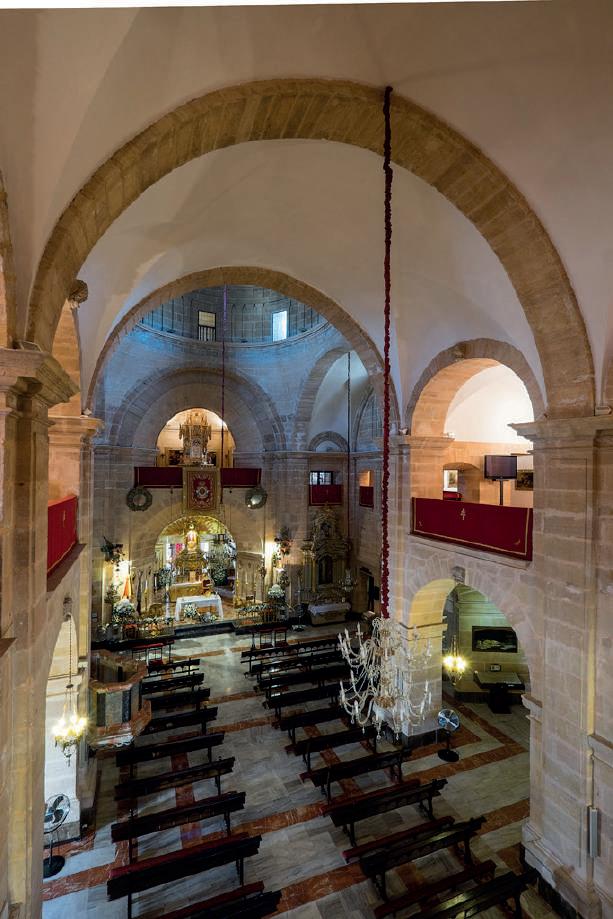
Esta bella muestra de arquitectura religiosa, joya del renacimiento murciano, fue edificada entre los siglos XVI y XVIII. La iglesia, lamentablemente inconclusa, es de planta salón y tiene tres naves que descansan sobre anchos muros y sobre cuatro columnas nervadas, de estilo jónico (de casi dos metros de diámetro cada una de ellas), que sostienen a gran altura las bóvedas con nervios góticos de crucería. Alrededor de las tres naves se disponen siete capillas costeadas por varias de las familias nobles de la localidad. En algunas de ellas pueden observarse las magníficas rejas del artesano Ginés García. Entre los tracistas cabe citar a Jerónimo Quijano y a Pedro Monte de Isla; entre los constructores a: Juan Garzón, Pedro de Homa y su sobrino Martín de Homa, Pedro de Antequera, Pedro y Andrés Monte, Damián Plá y Miguel de Madariaga entre otros. En dicha iglesia también cabe destacar el retablo del
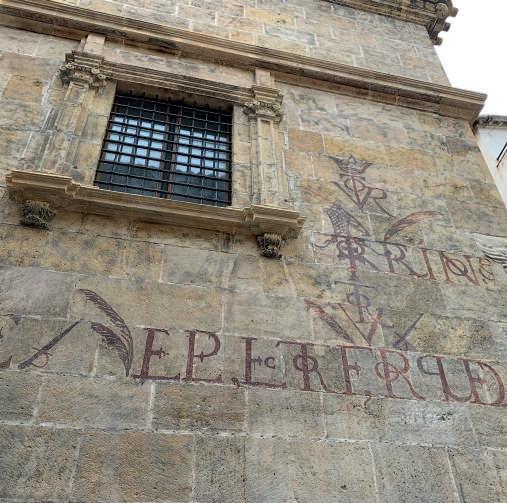

This beautiful example of religious architecture, a jewel of the Renaissance in Murcia, was built between the 16th century and the 18th century. The church, unfortunately unfinished, consists of a hall floor plan and has three aisles that sit on broad walls and four ionic-style ribbed columns (almost two metres diameter each), supporting at a great height the gothic cross-ribbed domes. Seven chapels, initially paid for by several of the noble families of the town, line the three aisles. In some of these, magnificent grilles made by artisan Ginés García can be seen. Among the designers, it is worth mentioning Jerónimo Quijano and Pedro Monte de Isla. Among the builders, Juan Garzón, Pedro de Homa and his nephew Martín de Homa, Pedro de Antequera, Pedro and Andrés Monte, Damián Plá and Miguel de Madariaga, among others, are worth naming. Also worth mentioning in this church is the high altar reredos by José altar mayor, obra de José Sáez, procedente de la desamortizada iglesia de los Jesuitas. Asimismo, merecen mención sus ricas muestras de pintura, orfebrería e imaginería de la escuela de Salzillo. En su exterior destaca su portada dividida en dos cuerpos: el inferior realizado a modo de arco de triunfo; en el segundo, una hornacina rematada por frontón curvo flanqueado por dos escudos (el de la ciudad y el de Santiago). También es digno de mención la famosa arpía con cabeza y pecho de mujer y cuerpo y garras de ave que se encuentra en la conocida “esquina de la muerte”, sobre la que se han tejido numerosas leyendas. Pero, sobre todo, destaca en el exterior su impresionante torre, cuyos cuerpos están hechos de cantería, rematada en el último por el campanario. Desde 2015 guarda en su interior una reliquia de San Juan Pablo II. Recientemente se han realizado labores de restauración en sus fachadas. La iglesia de El Salvador fue declarada Monumento Histórico-Artístico Nacional en 1983.
Sáez, taken out from the disentailed church of the Jesuits. The rich examples of paintings, gold, silver and precious metal ware and imaginery of the Salzillo School are also remarkable. The exterior features a façade which is divided into two sections: the lower part is a triumphal arch shaped door and the upper part has a niche topped with a curved pediment flanked by two shields (the town’s shield and Santiago’s shield). The famous harpy with woman’s head and chest and bird’s body and claws, situated in the area known as the “death corner”, upon which many legends have been created, is also remarkable. But, overall, the most striking exterior feature is the impressive tower, which bodies are stone worked, topped the last one by the bell tower. Since 2015, it keeps a relic of Saint John Paul II. Recently restoration work has been carried out on its facades. El Salvador Church was declared to be a Monument of National Historical and Artistic Heritage in 1983.
Edificada sobre el antiguo convento de franciscanos de Sta. María de Gracia fue inaugurada en 1880. En el año 1926 se remodeló, añadiéndosele entonces su espléndida fachada neomudéjar. Entre 1995 y 1999, el inmueble fue objeto de un proceso de rehabilitación.
It was built on the site of the ancient Santa Maria de Gracia Franciscan Convent and opened in 1880. In 1926 it was remodeled, adding its splendid neo-Mudejar front. The building was restored between 1995 and 1999.


Iglesia del siglo XVI, cuya edificación se levanta sobre una muralla de mampostería que sirve de muro de contención a la terraza del cerro, formando un plinto natural que sirve de base al inmueble, lo cual, junto a la solidez de los contrafuertes cilíndricos y prismáticos, confieren a la iglesia un aspecto fortificado de especial interés, que nos rememora el sentido medieval del templo como fortaleza de Dios heredado del gótico levantino.
Fue la primera parroquia que tuvo la localidad y actualmente es la sede del Museo Arqueológico, en donde se exponen restos que van desde el Paleolítico a la Edad Media.
It is a 16th-century church, whose building stands on a masonry wall that serves as a retaining wall to the terrace of the hill, forming a natural plinth that serves as the base for the building, which, together with the solidity of the cylindrical and prismatic buttresses, confer to the church a fortified aspect of special interest that reminds us of the medieval sense of the temple as a fortress of God inherited from the Levantine Gothic.
It was, at a time, the first parish church of the town. It is nowadays the site of the Archaeological Museum, which exhibits remains dating from the Paleolithic Period to the Middle Ages.
Magnífico ejemplo de arquitectura religiosa popular del siglo XVI. Destaca en su interior el artesonado mudéjar que apoya su estructura en seis columnas dóricas embutidas en las paredes de la única nave del templo sobre la que cruzan los respectivos arcos de medio punto donde cargan las vigas de madera. Destaca en la hornacina central del retablo mayor la Purísima Concepción, de Francisco Fernández Caro, discípulo de Francisco Salzillo. Destaca asimismo la llamada Torre de los Pastores, torre que tiene cuatro cuerpos: tres de sillería y el cuarto que remata con ladrillo macizo. En octubre de 2008 se procedió a la rehabilitación general de todo el inmueble.
Plaza de Toros.
Iglesia de La Soledad. Museo Arqueológico.
It is a magnificent example of popular religious architecture of the 16th century. Worth seeing on the inside is the Mudejar coffered ceiling, whose struc-
ture is supported on six Doric columns set into the walls of the church’s single aisle, where the respective half-point arches cross over, supporting the wooden beams. In the central vaulted niche, the high altar reredos of the Inmaculate Conception made by Francisco Fernández Caro, Francisco Salzillo’s disciple, is remarkable. Also worth visiting is the so-called “Torre de los Pastores”, a tower with four sections: three ones made of ashlar stone masonry and the fourth section that completes the tower, made of solid brick masonry. In October 2008, general rehabilitation of the entire property was carried out.
En la fundación del convento (1586) participó personalmente S. Juan de la Cruz, llegando a visitar la ciudad hasta en siete ocasiones. La Orden confía la creación de este convento al P. Nicolás Doria, el cual, a su vez, delega en el P. Juan de la Cruz, Vicario Provincial de Andalucía. En un principio los Carmelitas ponen el Santísimo Sacramento “en una casica harto pobre” que alquilaron cerca de la
iglesia de Ntra. Sra. de la Concepción. El 1-III-1587 se traslada el convento a su actual ubicación. Su realización se encargó al arquitecto de la Orden Fr. Alberto de la Madre de Dios y fue posible gracias a las donaciones de la Orden de Santiago y, sobre todo, a la especial ayuda de Don Rodrigo de Moya y Doña Mencía Monreal Chacón. En 1836, con la desamortización de Mendizábal, los Carmelitas se vieron obligados a abandonar la ciudad. El 29 de septiembre de 1904 regresaron a Caravaca tras 68 años de obligada ausencia teniendo desde entonces una gran presencia en la vida no solo religiosa sino también cultural de la localidad. Actualmente, el Convento alberga en su interior una hospedería.
Saint John of the Cross (San Juan de la Cruz) intervened personally in the convent’s establishment (1586), visiting the town even seven times. The Order entrusted the creation of this convent to Father Nicolas Doria who delegated


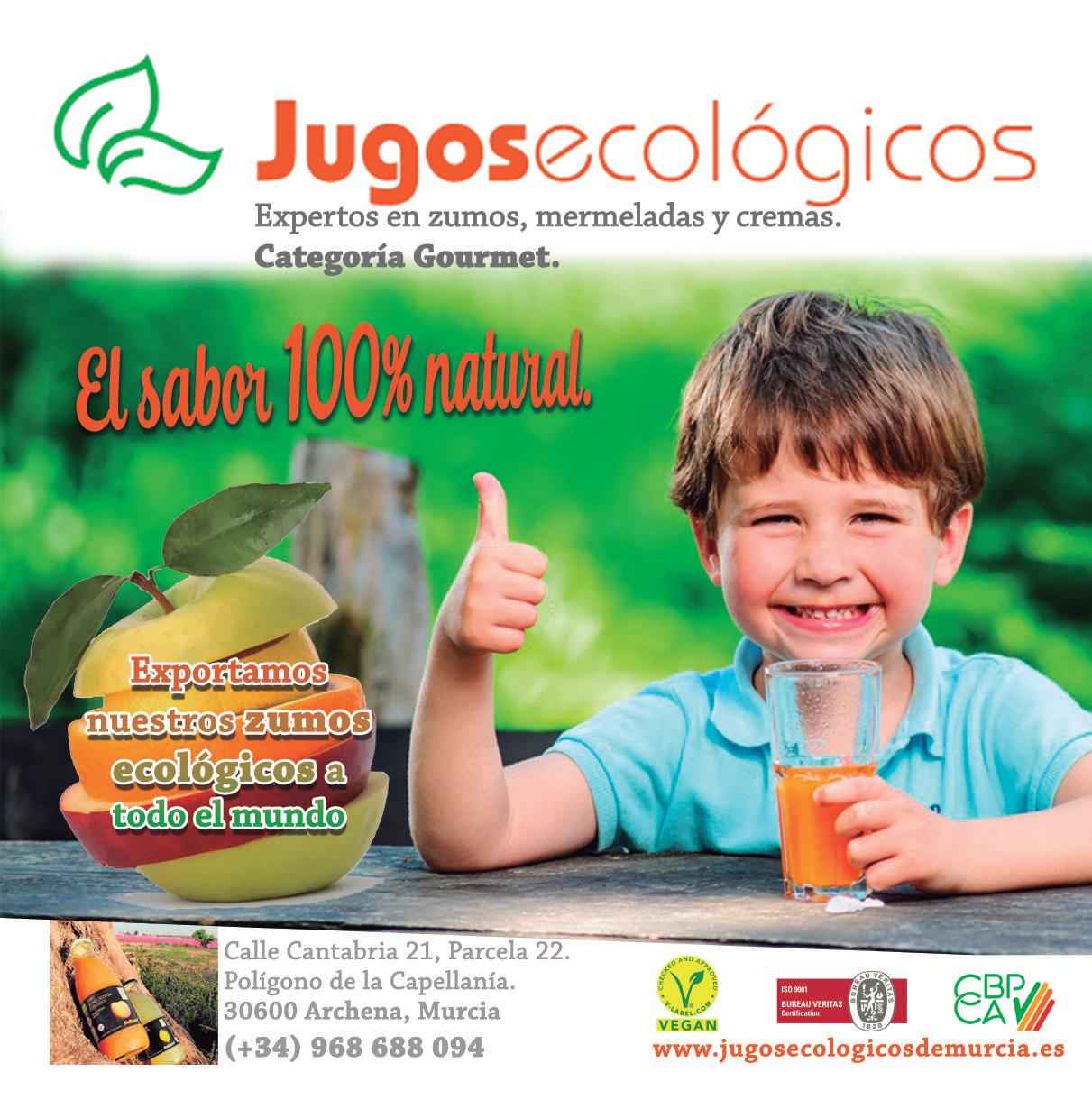
in Father John of the Cross, Provincial Vicar for Andalusia. At the beginning, the Carmelite Fathers placed the Blessed Sacrament in a “small poor house” that they rented near Ntra. Sra. de la Concepción Church. On March 1st, 1587 the convent was moved to its present site. The project was carried out by the Carmelite Order’s architect, Father Alberto de la Madre de Dios and this was rendered possible thanks to donations from the Order of Santiago and, above all, to the special aid of Mr. Rodrigo Moya and Mrs. Mencía Monreal Chacón. In 1836, with the Mendizabal Confiscation, the Carmelite Fathers were forced to abandon the town. After 68 years of obliged absence they came back on September 29th, 1904. From that moment onwards, they have had a great presence not only in the religious life of the town but also in its cultural life. Nowadays, the Convent houses an inn on its interior.
Fundado por Santa Teresa de Jesús en 1575, siendo el duodécimo convento de monjas de los 17 que finalmente instauró, a través de las gestiones de los PP. Julián de Ávila y Antonio Gaitán y de la madre Ana de San Alberto, primera priora. Destaca su bellísima iglesia del XVIII. Su ornamentación pertenece al último periodo del barroco: el rococó.
Caravaca de la Cruz, forma parte del denominado proyecto, “Ciudades Hermanadas por Santa Teresa de Jesús, que comenzó a trabajar conjuntamente con el resto de ciudades poseedoras de fundación dos años antes de la celebración del V Centenario del Nacimiento de la Santa (28 de marzo de 2015). En él se dan a conocer los valores históricos, culturales y religiosos de los santos del Carmelo, sobre todo de Santa Teresa de Jesús, pero también de San Juan de la Cruz, que está profundamente ligado a nuestra ciudad.
Este proyecto ha conseguido
una exitosa continuidad, siendo hoy día conocido como la ruta “Huellas de Teresa”.
It was founded by Saint Teresa of Jesus or of Ávila (Santa Teresa de Jesús o de Ávila) in 1575, being the twelfth convent of nuns of the seventeen convents that she finally established through the efforts of Father Julian de Ávila and Father Antonio Gaitán and Mother Ana de San Alberto, first prioress. It is emphasized its beautiful church of the 18th century; whose ornamentation belongs to the last baroque period: the Rococo.
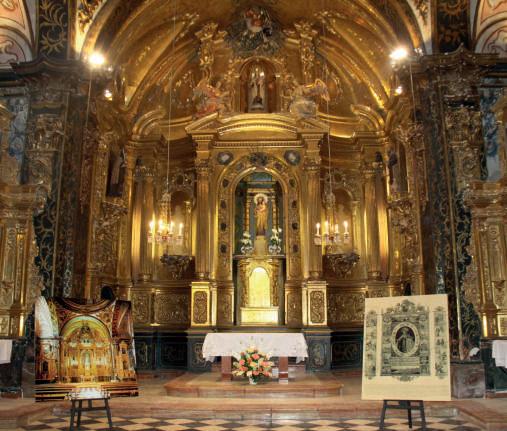
Caravaca de la Cruz is part of the so-called “Sister Cities twinned by Saint Teresa of Jesus” project, which began to work together with the rest of the cities that held a foundation two years before the celebration of the fifth centenary of the birth of the Saint (March, 28th 2015.) In this project the historical, cultural and religious values of the Carmelites, especially of Saint Teresa of Jesus, but also of Saint John of the Cross, who was deeply linked to Caravaca, are revealed.
This project has achieved a successful continuity, being today known as the “Huellas de Teresa” (literally Saint Teresa Footsteps).
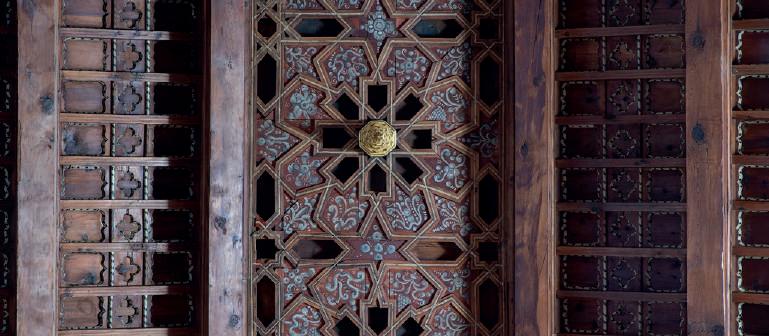
Edificio de estilo barroco y planta hexagonal inscrita en una circunferencia en el que se distinguen en su construcción cuatro cuerpos: el pódium, en el que se apoya el edificio y del que sobresalen los pilares; el cuerpo principal que cierra el espacio y configura el monumento; la cúpula sobre tambor cubierta de teja árabe y, por último, la linterna dotada de seis
vanos. La obra es de José López. Su construcción se inició en 1762 y concluyó en 1801. Este edificio también es conocido como El Bañadero, aludiendo así al acto ritual que cada 3 de mayo se realiza en él desde 1384 y que –bien puede decirse– ha sido la génesis de la fiesta, que en la primera semana del mes de mayo se celebra en honor a la patrona de la ciudad: la Stma. y Vera Cruz.
EIt is a small shrine or chapel of baroque style and hexagonal floor plan. It is set in a circumference where four sections are clearly differentiated: the pedestal, that held the building and where the pillars stand; the main body which encloses the area and shapes the monument; the dome over a closed tambour covered by Spanish clay roof tiles and, finally, the lantern tower with six openings. The work is made by José López.
Its construction started in 1762 and was completed in 1801. This building is also known as “El Bañadero” (a place where a “cross bathing” is done in order to bless the water), referring to the ritual that have taken place there every May 3rd since 1384. This can be said to be the origin of the festivities which takes place during the first week of May.They are celebrated in the name and honour of the True and Holy Cross of Caravaca.
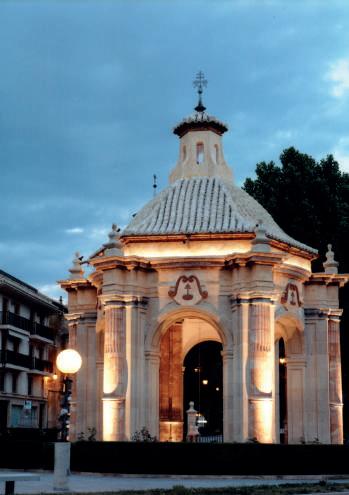
La construcción de este edificio barroco fue acordada en 1737. Obra de Jaime Bort en gran parte de su trazado original, sufrió modificaciones de fray Juan de Sta. Teresa y de Juan García Galán, siendo finalmente ejecutado por el maestro de obras caravaqueño Antonio del Campo. Las obras principales finalizaron en 1762 y la primera sesión se celebró el 3 de enero de 1763. Precisamente en la Sala de Plenos puede verse un enorme óleo sobre lienzo, copia de un original de Eduardo Rosales que actualmente se exhibe en el Museo del Prado; se trata del cuadro “El testamento de la reina Isabel La Católica”. En el tercer piso del inmueble se observa el escudo de la ciudad. A la izquierda teníamos el almudí o alhóndiga (almacén de compra-venta de grano) hoy convertido en oficinas municipales. Su construcción finalizó en 1807 como reza la lápida que hay bajo la ventana de la tercera planta. La Casa Consistorial experimentó en su día una profunda rehabilitación que la ha convertido en un edificio de interior moderno y funcional.
The construction of this baroque building was ordered in 1737. It is first Jaime Bort’s work in most of its original layout. It later underwent modifications by Friar Juan de Santa Teresa and Juan García Galán, and was finally built by the master builder from Caravaca, Antonio del Campo. The main work was completed in 1762 and the first meeting was held on January 3rd, 1763. In the Plenary Chamber, it can be seen an enormous oil on canvas, a copy of an original painting by Eduardo Rosales which is displayed now at the Prado Museum. The painting is “Queen Isabella the Catholic dictating her Will” (El testamento de la Reina Isabel La Católica). The city’s coat of arms can be seen on the third floor of the building. On the left there is the “almudí” or “alhóndiga” (grain exchange warehouse) that has been
Fue fundado el 27 de septiembre de 1609. La iglesia se construyó sobre el solar de la que fuera ermita de San Bartolomé que formaba parte, junto con otras trece, de un Vía Crucis cuyo final estaba en la ermita de la Reja (el conocido Calvario). La iglesia se concluyó entre 1715-18. Su planta es de cruz latina y sus bóvedas son vaídas en el crucero y de cañón en la nave central. En la cúpula existe un pequeño orificio por el que las Madres Clarisas dejan caer miles de pétalos de rosa en la mañana del día 4 de mayo cuando la Vera Cruz entra en la iglesia. La fachada, realizada en piedra, se divide en dos cuerpos: el primero es adintelado y enmarca la puerta de acceso; en el segundo y superior cabe destacar una hornacina rematada con pechinas vacías.
Entre sus ocupaciones, las Monjas Claras elaboran dulces artesanos y tradicionales.
transformed into municipal offices. It was completed in 1807 as it is said on the stone beneath the window on the third floor. The Town Hall underwent extensive refurbishment that has converted the interior building into a modern and functional place. Templete.
Founded in 1609, it was built on the site of San Bartolomé Shrine which, along with other thirteen chapels, was part of a Via Crucis or Way of the Cross that ended at the Shrine of La Reja (the well-known Calvary). The construction of the church was completed between 1715 and 1718. It has a Latin cross floor plan, domical vaults in the transept and barrel vaults in the central aisle. The Clare sisters drop thousands of rose petals by a small hole situated on the top of the dome in the morning of May 4th, when the Holy Cross enters the church. The facade, made of
stone, is divided into two sections: the first and lower one is straight and frames the access door; the second and upper one has a scallop shell niche with non-decorated pendentives.
The Clarisses nuns elaborate handmade and traditional sweets.
Esta edificación se acabó hacia 1614 y sigue el modelo de la arquitectura jesuítica, con planta de una sola nave y capillas laterales comunicadas entre sí. Su cúpula tiene una linterna con abertura de iluminación y se remata con pechinas en su día decoradas. Este edificio se fundó originariamente como Colegio y constaba de iglesia, claustro y numerosas dependencias para educandos y docentes. El edificio perdió su uso original tras la expulsión de los jesuitas en el reinado de Carlos III (1767). Con la desamortización de Mendizábal el edificio pasó a manos de particulares. Actualmente es un edificio de propiedad municipal que funciona como Centro Cultural.
The construction of the building was completed by 1614 and follows the Jesuitic architectural model. It has a single aisle floor plan and side chapels connected one to each other. Its dome has a lantern with an illuminating opening, and is finished with decorated pendentives. This building was originally founded as a school and comprised the church, cloister and many rooms for pupils and teachers. The building lost its original use after the Jesuits were expelled from Spain by King Charles III (1767). After the Mendizabal Confiscation, the building was privatised. It is currently a local government-owned building that operates as a Cultural Centre.
Ubicado en el bello paraje de las Fuentes del Marqués es una edificación del siglo XVI posiblemente erigida sobre una anterior de origen templario (de ahí su nombre). Actualmente alberga el Centro de Interpretación de la Naturaleza.
The “Torreón de los Templarios” is situated in the beautiful natural park of the Fuentes del Marqués (literally Springs of the Marquis), it is a 16th century building that was probably constructed on an earlier tower of Templar origin (hence its name). It currently houses the Nature Interpretation Centre.
Edificio de principios del siglo XVI –actualmente sede de la Agrupación Musical “Caravaca de la Cruz”–, ubicada en la Plaza del Santo, de planta rectangular y cubierta con armadura de madera a dos aguas sobre tres arcos de diafragma apuntados; posee presbiterio y coro alto, quedando así la iglesia dividida en tres planos. En su interior destacan unas pinturas murales tardogóticas a modo de retablo.
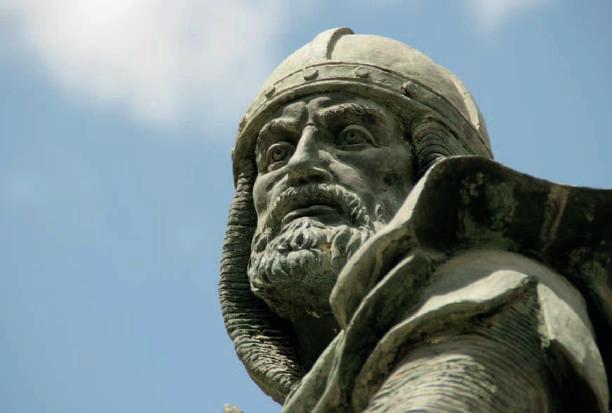
The “Ermita de San Sebastián” or “Ermita del Santo” is a building –today the site of the “Caravaca de la Cruz” Musical Group– from the early 16th century, located in Plaza del Santo (The Saint Square), with a rectangular floor plan and a gabled, wood-framed roof that rests on three pointed diaphragm arches; it has a chancel or presbytery and a rood screen overlooking the aisle, what divides the church into three spaces. Inside, there are some late-Gothic wall paintings making a high altar reredos.
Edificio del siglo XVII, de planta cuadrada. Es una de las 14 ermitas que formaban parte del Vía Crucis. Sobre la reja que le da nombre puede verse una lápida que contiene los nombres de quienes la mandaron construir: D. Fco. Muñoz de Otalora y Dña. Catalina López.
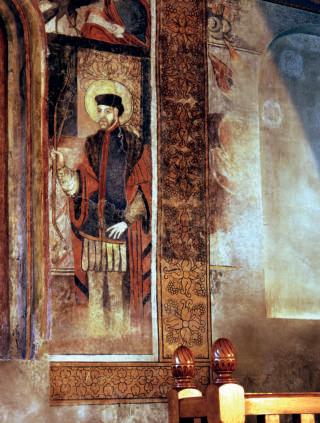
The “Ermita de la Reja” is a rectangular floor plan building constructed in the 17th century. It is one of the few remainings of the fourteen shrines that once formed the Via Crucis or Way of the Cross. On the railing giving it its name, a stone shows the names of those who ordered its construction: Francisco Muñoz de Otalora and Catalina López.
Pequeña iglesia de una sola nave cuya construcción se inicia en el primer cuarto del siglo XVII. Destaca en ella la imagen de vestir de Nuestro Padre Jesús Nazareno de gran devoción popular, teniendo lugar aquí el solemne besapies del primer viernes de marzo.
This is a small, single aisle church whose construction started in the first quarter of the 17th century. Important here is the adorned image of Our Father Jesus Nazarene (Nuestro Padre Jesús Nazareno), of great popular devotion. Here is where the solemn “besapiés” (feet-kissing) ceremony takes place on the first Friday of March.
Además de estos monumentos el visitante puede conocer la Plaza del Arco, con el Monumento al Moro y al Cristiano, la Plaza San Juan de la Cruz, con un Monumento al Santo y en la Cuesta del Castillo el conjunto escultórico dedicado a la carrera de los Caballos del Vino, los tres monumentos obra de Rafael Pí. En la plaza de los Caballos del Vino existe también un monumento dedicado al festejo, y frente a la puerta principal de entrada al Castillo podemos ver el monumento al Peregrino en Bicicleta de Antonio Campillo. También puede pasear por cualquiera de sus muchas calles repletas de viejas casonas blasonadas.
In addition to these monuments, visitors will discover the Plaza del Arco, which houses the Monument to the Moor and the Christian, Plaza San Juan de la Cruz, with a Monument to this Saint and on the slope of the castle the monument set dedicated to the race of the Wine Horses; the three monuments are the work of Rafael Pí. In the Plaza de los Caballos del Vino there is also a monument dedicated to this celebration and in front of the main entrance to the castle it can be seen the monument to the Pilgrim on a Bicycle made by Antonio Campillo. Visitors can also take a stroll through the many streets that boast magnificent emblazoned large homes of yesteryear.
Ubicado en el recinto de la Basílica-Santuario comprende colecciones de ornamentos, orfebrería y pintura, así como importantes documentos relacionados con la Cruz. Dentro de la pinacoteca destacan: “La curación de Tobías”, óleo sobre lienzo del pintor caravaqueño Rafael Tegeo, uno de los mejores retratistas del siglo XIX español, de estilo neoclásico; “San Francisco en la Zarza”, óleo sobre lienzo del siglo XVII de la Escuela de
Ribera. Además, destacan seis óleos sobre tabla del siglo XVI, originales de Hernando de Llanos, pintor que fuera discípulo de Leonardo da Vinci, en los que se narra el Milagro de la Aparición.
En ornamentos destaca la “Casulla de Chirinos” (un tiraz musulmán adaptado a la forma de ornamento litúrgico que se cree portaba el sacerdote Chirinos en el momento de la milagrosa aparición de la Cruz).
En orfebrería encontramos la Custodia-Ostensorio de la Cruz (de principios del siglo XVI), regalo del primer Marqués de los Vélez, Pedro Fajardo. El Portacruz de los Baños, regalo de Luis Fajardo, segundo Marqués de los Vélez, es otra pieza importante. Digna de mención, en la Capilla de la Cruz, se encuentra la caja-estuche de plata sobredorada donada hacia 1390-95 por el maestre de la Orden de Santiago, Lorenzo Suárez de Figueroa. En dicho museo se encuentra también el carro procesional de la Stma. Cruz, conjunción de tallas policromadas y elementos en plata que dan como resultado una obra de orfebrería excepcional.
También es visitable parte del antiguo Castillo, en donde se puede ver una mazmorra de la época.
The “Vera Cruz” museum is located in the premises of the Basilica-Sanctuar. It houses several religious vestments, silverwork and paintings collections as well as important documents related to the Cross. In the art gallery the following paintings can be highlighted: “La curación de Tobías”, an oil on canvas painting by the artist from Caravaca, Rafael Tego, that describes Tobias healing, one of the best portrait painters of the Spanish 19th century epoch, of neoclassical style; “San Francisco en la Zarza”, an oil on canvas painting from the 17th century from the Ribera School. Other six oil on panel paintings from the 16th century stand out too. These are the original
paintings by Hernando de Llanos, Leonardo da Vinci’s disciple, that describe the miracle of the appearance of the Holy Cross.
Among the vestments, the “Chasuble of Chirinos” (Islamic tiraz or brocade tiraz with liturgical vestment shape that the priest Chirinos is believed to wear at the moment of the miraculous appearance of the Cross) is highlighted.
Among the silverwork we can find the Monstrance-Ostensorium of the Cross (beginning of the 16th century), a gift from the first Marquis of Velez (Marqués de los Vélez), Pedro Fajardo. The “Portacruz de los Baños” (Monstrance), a gift from Luis Fajardo, the second Marquis of Velez (segundo Marqués de los Vélez), is another important piece. Worth mentioning, in the Cross Chapel, is the gilded silver box-case donated around 1390-95 by the grand master of the Order of Santiago, Lorenzo Suarez de Figueroa. In this museum there is also the processional cart of the Holy Cross, conjunction of polychromatic wooden carvings and silver elements that result in an exceptional silverwork.
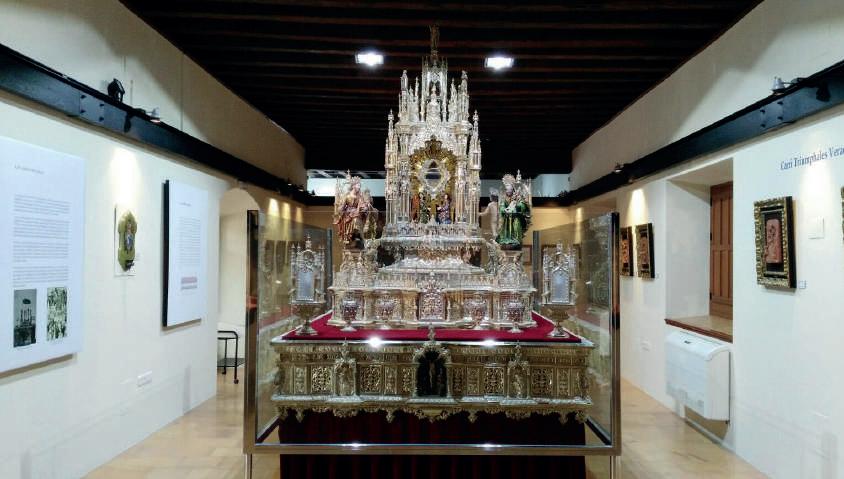
Part of the old plan of the Castle can now be visited; an old dungeon from this ancient time can be seen.
El Museo Arqueológico es un equipamiento de primer orden situado en la Cuesta del Castillo, en pleno centro histórico y dentro de un edificio de gran valor patrimonial, como es la antigua Iglesia de Ntra. Sra. de la Soledad, primera parroquia fundada en Caravaca de la Cruz.
Recoge piezas de gran valor, fruto de los numerosos hallazgos realizados en las excavaciones efectuadas en diversos yacimientos arqueológicos, sobre todo en las llevadas a cabo en el complejo íbero-romano de “La Encarnación”. En este museo podemos encontrar cerámicas, armas, monedas, elementos arquitectónicos, etc.
The Archaeological Museum is a top quality facility situated on the castle slope, in the historical centre and inside a building with great patrimonial value, which is the ancient Ntra. Sra. de la Soledad Church, first parish church founded in Caravaca de la Cruz. It houses several pieces of great value, the fruit of the many findings made in the excavations carried out in different archaeological sites, above all those
carried out in the Iberian-Roman complex of La Encarnación. Pottery, weapons, coins, architectural elements, among others can be found in this museum.
Se encuentra ubicado en la antigua Casa de los Uribe, sita en la Calle de las Monjas. En el mismo se muestran trajes cristianos y moros, ornamentos utilizados en las fiestas que en honor de la Stma. y Vera Cruz, se celebran del 1 al 5 de mayo, así como, los atalajes con los que se enjaezan a los Caballos del Vino en la mañana del día 2 de mayo (vestimentas bordadas con hilo de seda, plata y oro).
“La fiesta” museum is located in the ancient Casa de los Uribe (Uribe House), in Calle de las Monjas. Here Christian and Moorish costumes are exhibited, as well as vestments used in the festivities held in honour of the Holy Cross, that take place from the 1st to the 5th of May. The neckbands and costumes used to harness the “Wine Horses” on the morning of the 2nd of May (gold, silver and silk embroidered clothing) are also exhibited there.
El Museo de Música Étnica de Barranda, colección Carlos Blanco Fadol, es un museo temático que tiene como finalidad presentar a todo tipo de público las formas, sonidos e información en general sobre instrumentos y músicas del mundo. La tarea de recopilación de estos instrumentos musicales étnicos, ha sido realizada por el etnomusicólogo Carlos Blanco Fadol, a lo largo de casi cuarenta años, por los cinco continentes, haciendo posible esta insólita muestra.
El Museo de Música Étnica de Barranda ofrece una muestra temática de los mismos, para que el visitante pueda entender mejor cuáles eran las funciones para las que fueron creados o los usos que adquirieron con el paso del tiempo. Podemos ver instrumentos asociados a la religión, la esclavitud, la magia y la brujería, instrumentos que imitan el sonido de los animales, usados otros para enamorar, instrumentos de mendigos nómadas o instrumentos de guerra.... todo un mundo de sensaciones para oír y mirar, un punto de referencia para que las generaciones venideras tengan conocimiento de la cultura musical de los pueblos del mundo.
It is a themed museum for all ages whose aim is to the shapes, sounds and general information about instruments and music around the world. The task of bringing together this collection of ethnical musical instruments was done by Carlos Blanco Fadol. It took forty years to complete and they were collected from the five continents, to culminate in this unique exhibition.
The Barranda Ethnic Music Mu-
seum offers a themed exhibition of these instruments to offer visitors a greater understanding of the functions for which they were created or the uses that they acquired over time. On display are instruments associated with religion, slavery, magic and witchcraft, instruments that mimic the sounds of animals, some other used for love conquests, instruments of nomadic beggars or instruments of war, among others. A whole host of sensations to listen and watch, a point of reference to provide future generations with knowledge about the musical culture of people throughout the world.
En la antigua casa de la familia Muso Muñoz Melgarejo, del siglo XVIII, totalmente rehabilitada, se encuentra ubicado este espacio dedicado a los Caballos del Vino, un recorrido desde sus orígenes hasta la actualidad donde están representados todos los aspectos de la fiesta: los caballos a pelo, el diseño, bordado y piezas del Enjaezamiento, la Carrera… A través de diversas salas y audiovisuales se pretende transmitir y difundir con orgullo lo que son las raíces y el presente de un festejo que en la actualidad es candidato a Patrimonio Cultural Inmaterial de la Humanidad.
The “Casa- Museo de los Caballos del Vino” is situated in the former house of the Muso Muñoz Melgarejo house, from the 18th century, totally rehabilitated, and it dedicated to the Wine Horses. It makes a tour from its origins up to the present moment where all the aspects of this festivity are represented: the non-dressed horses, the design, embroidery and pieces of the Wine Horses costume, the competition race, among other. Across diverse rooms and audiovisual supports, it tries to proudly transmit and spread the roots and the
present moment of this festivity that is currently an Intangible Cultural Heritage of the Humanity candidate.
Este espacio expositivo está ubicado en el que fuera palacete de la familia Muñoz Otarola y casa natal del artista caravaqueño José Carrilero, en el que se pueden admirar 90 obras escultóricas y pictóricas del escultor local.
De esta forma se cumple el deseo del autor para que su obra, dispersa durante algún tiempo por diferentes ciudades, pueda exponerse definitivamente en su ciudad natal.
La obra del autor caravaqueño se caracteriza por una expresiva compatibilización del clasicismo con posturas renovadas, fruto de su aportación personal. Rasgos destacables de su obra escultórica son su particular tratamiento de la figura humana, los contrastes de luz y sombra o el tratamiento de las superficies.
Todo ello, conjugado con el protagonismo concedido a la acción y el movimiento y la capacidad de generar sentimientos dramáticos a partir de recursos formales, lo cual, determina una obra madura que tie-
ne una gran proyección nacional e internacional.

This exhibition space is located in the Muñoz Otarola family mansion and the later home of the Caravaca-born artist José Carrilero. Visitors can admire 90 sculptural and pictorial works by the local sculptor.
The space delivers on the artist’s wish to have his works, which for some time were dispersed around different cities, on permanent display in his home town.
The work of the Caravaca-born artist is characterised by an expressive harmonisation of classicism with renewed postures, the fruit of his personal contribution. Outstanding features of his sculptural work are his special treatment of the human figure, contrasts of light and shadow and his treatment of surfaces. All of this, together with the special focus on action and movement and his ability to produce dramatic feelings from formal resources, comprises a mature body of work with significant national and international projection.



Ubicado en el llamado “Torreón de los Templarios”. Edificación del siglo XVI, está situado a la entrada del paseo principal de “Las Fuentes del Marqués”, y sobre el que la imaginación popular ha tejido numerosas leyendas. El Centro de Interpretación de la Naturaleza viene a ser el colofón didáctico de todo lo que de singularidad, atractivo y natural tiene no solo el marco ya descrito, sino toda la zona noroeste de la Región de Murcia. En él se ha tratado de aprovechar didáctica e interpretativamente las idóneas condiciones del paraje a través de los distintos estudios y proyectos realizados, fomentar la información y formación ambiental del usuario y visitantes de Las Fuentes, potenciar la oferta lúdica y cultural de Caravaca de la Cruz, así como ampliar la oferta turística en el campo del Turismo de Naturaleza.
Located in the so-called “Templar Fortified Tower” (Torreón de los Templarios), a 16th century building, is situated at the entrance to the main avenue of “Las Fuentes del Marques”. People have imagined many legends about this tower. This visitors Centre is the didactic culmination of all the singularity, attraction and naturalism, not only of the framework already described, but in the whole North-eastern area of the Region of Murcia. Here, the aim was to take advantage both didactically and interpretatively, of the appropriate conditions of the place through the different studies and projects carried out, fostering the information and environmental education of the users and visitors of “Las Fuentes”, promoting the ludic and cultural offer of Caravaca de la Cruz, as well as increasing the tourism in the field of Nature Tourism.
Uno de los lugares arqueológicamente más ricos de la Región es Caravaca de la Cruz y dentro de él un emplazamiento llamado Estrecho de las Cuevas, pequeño valle atravesado por el río Quípar próximo a la pedanía de La Encarnación.
Lugares de gran interés arqueológico del municipio de Caravaca de la Cruz:
- CUEVA NEGRA (PALEOLÍTICO MEDIO)
Situado en el complejo arqueológico de La Encarnación. Este yacimiento tiene aproximadamente 800 000 años de antigüedad. En él se han obtenido piezas dentarias y fragmentos de huesos del hombre fósil europeo del tipo preneandertal así como restos óseos de animales de aquel periodo. Los restos paleolíticos de este yacimiento conforman un singular conjunto “achelense-levaloisomusteroide” que es el más antiguo de semejante clasificación en Europa. Se ha podido constatar que el fuego de la Cueva Negra tiene una antigüedad de 800 000 años, por lo que el yacimiento se convierte en referencia obligada del Pleistoceno de Europa.
Yacimiento situado en las terrazas altas del valle del río Argos al sur del casco urbano de Caravaca de la Cruz. Las estructuras que caracterizan a este poblado son silos, fondos de cabañas semiescavados en la roca y fosos. También se ha podido reconocer una fase ibérica, romana y otra islámica. Próximo al poblado se ha encontrado un enterramiento datado hace unos 4 500 años con más de 1 300 esqueletos humanos y 50 canes, lo que lo convierte en el enterramiento prehistórico más grande e importante de la península ibérica.
Situado en el complejo arqueológico de La Encarnación es el más impor-
tante yacimiento de este período (1800-1200 a. C.) de la comarca. Protegido por una muralla defensiva ocupa la planicie superior de una colina con escarpes laterales y rodeada, en su flanco izquierdo, por el río Quípar. Sin excavar.
- LOS VILLARES (POBLADO IBÉRICO ANTIGUO)
Igualmente, situado en el complejo arqueológico de La Encarnación. Este poblado está ubicado en el margen derecho del río Quípar sobre una amplia meseta protegida por una muralla con torres rectangulares en los sectores sur y este. Dentro del poblado, en su extremo noroeste, aparece un sector ligeramente sobreelevado a modo de acrópolis. Pudo ser habitado entre los siglos VII y VI a. C. Sin excavar.
- LOS VILLARICOS (POBLADO ÍBERO-ROMANO)
Situado en el complejo arqueológico de La Encarnación. Constituye un nuevo poblado situado en el margen izquierdo del río Quípar, frente al yacimiento de Los Villares y probablemente de fundación a finales del siglo VI o inicios del V a. C. Ofrece una amplia superficie en pendiente protegida por una elevada muralla. En su interior se observan restos de construcciones y alineaciones de calles y casas. Este yacimiento pudiera corresponder al municipio romano de Asso, mencionado por el geógrafo Ptolomeo en el siglo II d. C. Sin excavar, salvo la necrópolis ibérica.
- CERRO DE LA ERMITA (SANTUARIO ÍBERO-ROMANO)
Situado en un cerro al sur del complejo arqueológico de La Encarnación, delimitado por los barrancos de la Ermita y el de los Canteros y bajo las actuales estructuras de la Ermita y en sus inmediaciones. Consiste en dos templos romanos de orden jónico que sustituyeron al inicio del siglo II a. C. las frágiles edificaciones de un santuario ibérico anterior. A lo largo de tres fases constructivas sucesivas los templos fueron agrandados y
monumentalizados. En su fase inicial son hasta el momento los templos romanos más antiguos de la península ibérica.
Localizado en la pedanía de Archivel, se encuentra en él un castillo tardo-republicano romano de mediados del siglo I a. C., época en la que tuvo lugar la guerra civil entre Julio César y Pompeyo Magno. La construcción está dotada de un excelente y original sistema defensivo con puerta de acceso flanqueada por torres cuadradas y un antemuro de unos 11 m de longitud, conocido en la arquitectura militar romana como titulum. Los indicios de presencia humana en este cerro (con breves intervalos temporales de abandono) van desde un poblado argárico del segundo milenio antes de Cristo –el doblamiento inicial lo tuvo en Casa Noguera– hasta el siglo X d. C., período islámico.
En las proximidades de una ermita perteneciente a la pedanía de Singla se encuentran los restos de un establecimiento rural romano del siglo IIIII d. C. sobre el que posteriormente se estableció una necrópolis (siglos IV-V d. C.). Este yacimiento romano es uno de los muchos –aunque de menor entidad– que atesora la zona, lo que prueba la importante romanización del noroeste murciano, comparable al del litoral de la Región.
Situadas entre Caravaca de la Cruz y Cehegín a la altura de una encrucijada de caminos llamada El Empalme. Se distinguen dos momentos de ocupación que van entre los siglos I d. C. y el VI / VII d. C. La edificación termal inscribe sus habitaciones en un rectángulo a lo largo del cual se suceden el vestuario, las salas para los baños fríos, templados y calientes. Adosada a esta última se halla un profundo pozo (que probablemente albergó una noria) así como una piscina de grandes dimensiones.
En este yacimiento situado en la pedanía caravaqueña de Barranda, próximo al paraje conocido como Fuente de las Tosquillas, encontramos los restos de una torre romana del s. I a. C. destinado a la vigilancia del valle conformado por los ríos Argos y Quípar, en las mismas fechas que el Cerro de Las Fuentes de Archivel.
One of the places of greatest archaeological interest in the Region is Caravaca de la Cruz, specially a place called Estrecho de Las Cuevas (literally the Strait of the Caves), a little valley crossed by the Quípar River near to La Encarnación village.
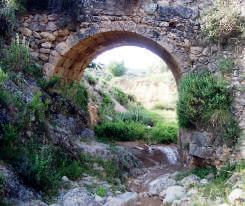
Places of great archaeological interest in Caravaca de la Cruz district:
It is situated in La Encarnación archaeological complex. This site is approximately 800,000 years old. Findings here include teeth and bone fragments of European fossil pre-Neanderthal human and bone remains of animals of this period. This site’s Palaeolithic remains form a unique “achelense-levaloisomusteroide” collection, being the most ancient finding of this classification in Europe. It has been stated that the fire of the “Black Cave” has an antiquity of 800,000 years, being a reference of Europe’s Pleistocene.
Archaeological site on the high terraces of the valley of the Argos River, on the south of Caravaca de la Cruz urban area. The structures found in this settlement are silos, huts remains half dug into the rock and ditches. Iberian, Roman and Islamic periods have also been recognised. Near the settlement, a burial ground dated 4,500 years old has been found, with over 1,300 human skeletons and 50 dog skeletons inside. This makes it the biggest and
Situated in La Encarnación archaeological complex, it is the most important finding of this period (18001200 BC) in the Region. Protected by a defensive wall, it is located on the upper flatland of a hill with lateral escarpments and is bordered, on its left flank, by the Quípar River. Unexcavated.
Also situated in La Encarnación archaeological complex. This settlement is located on the right bank of the Quípar River on a wide tableland protected by a wall with rectangular towers in the South and East sides. Inside the settlement, at its Northwestern end, there is a slightly raised sector like an acropolis. It may have been inhabited between the 6th and 3rd centuries BC. Unexcavated.
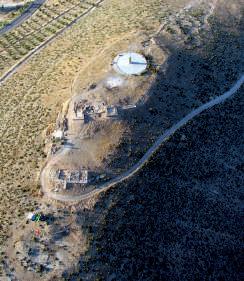
Situated in the La Encarnación archaeological complex. It is a new settlement situated on the left bank of the Quípar River, facing Los Villares settlement and probably founded at the end of the 6th century and the beginning of the 5th century B.C. It has a large sloping surface area protected by a high wall. Buildings and street constructions and layouts exist in its interior. This site could be the Roman settlement of Asso, mentioned by geographer Ptolomy in the 2nd century A.D. Unexcavated, except for the Iberian necropolis.
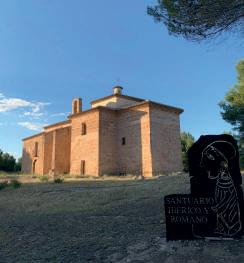
Situated on a hill on the South of La Encarnación archaeological complex, delimited by La Ermita and Los Canteros canyons and beneath the current structures of La Ermita (Shrine) and its immediate vicinity. It consists of two Roman ionic-style temples that
replaced at the beginning of the 2nd century BC the fragile buildings of an earlier Iberian sanctuary. Along three successive construction phases, the temples were enlarged and monumentalised. If we refer to their initial phase, they are the oldest Roman temples that have been discovered in the Iberian Peninsula.
Located in a hill next to the village of Archivel, it has a late republican Roman castle dating from the 1st century BC, the period when the civil war between Julius Caesar and Pompeius Magnus took place. The construction has an excellent and original defensive system with an access door flanked by squared towers and an outer wall of 11-m length, known as titulum in the military Roman architecture. The indications of human presence on this hill (with brief intervals of abandonment) run from an Argaric settlement in the second millennium B.C - the initial settlement was at Casa Noguerathrough the 9th century AD, during the Islamic period.
Near to a shrine belonging to the Singla village are the remains of a Roman rural settlement of the 2nd century and the 3rd century AD, on which a necropolis was later erected (4th to 5th centuries BC). This Roman settlement is one of the many - although smaller - in the area, demonstrating the big extent of the Romanisation period in the Northwest of Murcia compared to the one of the Region’s coastline extent.
TERMAS DE EL EMPALME (ROMAN PERIOD): Situated between Caravaca de la Cruz and Cehegín at a crossroad called El Empalme we can find these thermal baths. Two inhabited periods can be distinguished in between the 1st century AD and the 6th - 7th Centuries AD. The thermal building has its rooms set out in a rectangle, including the changing room, the rooms for cold, temperate and warm baths. Next to the last room, there is a deep well (which probably housed a water-
wheel) and a large swimming pool.
LA CABEZUELA (ROMAN PERIOD): This site is situated in Barranda, village that is part of the Caravaca district, near to the natural park known as Fuente de las Tosquillas (Las Tosquillas Sources). There we are able to find the remains of a Roman tower dating from the 1st century BC, used to watch over the valley formed by the Argos and Quípar Rivers, in the same period as Las Fuentes de Archivel (Archivel Sources).
Zona de interés arqueológico. Puente del Piscalejo.
most important prehistoric burial site in the Iberian Peninsula.Antigua Ermita de La Encarnación. El Cerro de las Fuentes. Pedanía de Archivel.
Hay que destacar que, al igual que el nombre de la ciudad está ligado a la Cruz, una de las principales labores artesanas, que se viene realizando desde tiempos antiguos, es la elaboración de reproducciones de la Cruz de Caravaca por parte de los joyeros locales, desde las más sencillas en plata hasta trabajos de enorme calidad y valor artístico realizados en oro. Entre otras actividades del sector que tienen implantación en el municipio podemos destacar: la elaboración de turrones y dulces típicos como el alfajor y las yemas, la chacinería y charcutería con exquisitos embutidos, la panadería, la apicultura y sus derivados, el diseño y la decoración de interiores, la bisutería y los trabajos en metal con especial dedicación a los trajes y ornamentos festeros, la forja y cerrajería artística, la confección de magníficos bordados artísticos, la elaboración de esencias naturales, la carpintería y ebanistería, la camisería y sus complementos, la marroquinería, el calzado con la tradicional alpargata, etc.
A lo largo del año nuestro ayun-
tamiento promueve la celebración de varios eventos que ofrecen a nuestros visitantes variadas muestras del quehacer artesano:
Se celebra en el Paseo de La Corredera de nuestra ciudad, entre las 10:00 h y las 14:30 h el tercer domingo de los meses de noviembre a abril, y el tercer sábado tarde de mayo y junio (de 17:30 h a 21:00 h). En él se puede tener un agradable encuentro con artesanos locales y regionales que ofrecen lo mejor de sus productos puestos al servicio del buen comer, del regalo y la decoración en medio de un ambiente que en cada edición está inspirado en una temática distinta.
Se celebra siempre el último fin de semana de enero junto con la “Fiesta de las Cuadrillas”, declarada de Interés Turístico Nacional, en la pedanía de
Barranda. En él podemos encontrar una exposición de útiles campesinos y aperos de labranza, un taller de destilación de plantas aromáticas, una taberna para disfrutar de la típica carne a la brasa autóctonos de alimentación, y la gran variedad de artesanos que ofrecen sus productos tradicionales de alimentación, decoración y regalo.
Se ubica en pleno centro del casco histórico- artístico de la ciudad: En
la Plaza del Arco y Plaza Nueva, y en la calle Puentecilla, calle Las Monjas, calle Mayor, Paseo de Sta. Clara, etc. Se celebra durante el “Puente de la Constitución”, alrededor de los días 6, 7 y 8 de diciembre. En él la artesanía con mayúsculas se da cita en nuestra ciudad, acudiendo artesanos de toda la geografía nacional con lo mejor de sus productos y, junto a ellos, toda una serie de actividades para el disfrute del visitante: demostraciones artesanas, juegos, animaciones de calle y espectáculos varios para pequeños y grandes.
As well as the city’s name is directly related to the Cross (Cruz), one of the principal craft works, that has been made from ancient times, is the production of reproductions or copies of Caravaca’s Cross by local jewelers, from the simplest ones made in silver up to works of enormous quality and artistic value realized in gold.
Among other activities of the sector that have been introduced in the district, we can stand out: the production of Spanish nougats and typical sweets like “alfajor” (Spanish almond pastry sweet) and “yemas” (sweet yolks covered with chocolate or caramel sauce), the exquisite “chacinería” (pork butcher’s products) and “charcuteria” (specialist butcher’s products) that make exquisite “embutido” (usually cold pork sausages), bakery, apiculture and its byproducts, design and interior decoration, trinkets and
metal works, specially the costumes and vestments used during the festivities, artistic forge and locksmithing craft, the sewing of magnificent artistic embroideries, the production of natural essences or perfumes, carpentry and high-quality woodmaking, haberdashery and accessories, leather industry, footwearing, with the traditional “alpargata” (esparto rope soled sandal), among others.
Throughout the year our City Council promotes the celebration of several events that offer the visitors different samples of craftsmen work:
It is celebrated in the walk of “La Corredera” street of Caravaca from 10h00 to 14h30. It takes place every third Sunday of the month from November to April, and every third Satur-
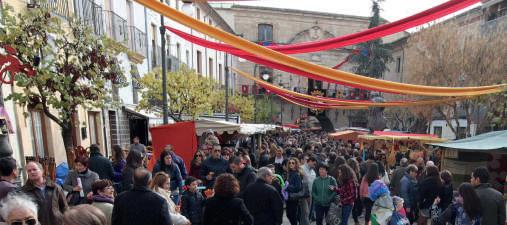
day afternoon in May and June (from 17h30h to 21h00). Here it is possible to have a pleasant meeting with local and regional craftsmen who offer the best part of their products thus their best groceries, presents and accessories, always into a themed environment that is inspired in a different subject every new event.
It is always celebrated the last weekend of January together with the Las Cuadrillas Festivity (“Traditional Music Festivity”), declared to be of National Turistic Interest, in Barranda, one of our villages. Here we can find an exhibition of farming tools and tillage equipments, an aromatic plants distilling workshop, a tavern to enjoy the typical charcoal-grilled meat, and
also the different craftsmen that offer their traditional products of groceries, accessories and presents.
It is located in the historical and artistic centre of the city: Plaza del Arco and Plaza Nueva, calle Puentecilla, calle Las Monjas, calle Mayor, Paseo de Santa Clara, among others. It is celebrated during December long weekend, around December the 6th, 7th and 8th. A market specially dedicated to handicraft where craftmen from the whole national geography arrive to show and sell their best products. Together with them, a whole series of activities take place for the visitor’s pleasure: artisan work exhibitions, games, street entertainment groups, and different shows for children and adults.
EN HONOR DE LA STMA. Y VERA CRUZ
Declaradas de Interés Turístico Internacional. Tienen lugar del 1 al 5 de mayo. Celebradas en honor a la Stma. y Vera Cruz, patrona de la ciudad, conmemoran hechos acaecidos en el largo período en que Caravaca fue plaza fronteriza con el reino nazarí de Granada. Etnológicamente es de enorme interés el festejo de los Caballos del Vino.
El día 2 de mayo por la mañana se rememora la aparición de la Santa Reliquia ocurrida en 1231. Por esta milagrosa aparición el alcaide moro de la plaza y todos sus hombres abrazaron la fe católica. La Misa de Aparición se celebra tradicionalmente en la mañana de este día 2 en El Templete.
Es también el único día en que los Caballos del Vino salen a la calle. Este FESTEJO ES ÚNICO EN EL MUNDO Y ESTÁ DECLARADO PATRIMONIO CULTURAL INMATERIAL DE LA HUMANIDAD POR LA UNESCO. En un principio estos caballos tenían como finalidad subir el vino al Santuario para ser bendecido. Con el paso del tiempo, los odres de vino fueron sustituyéndose por lujosos mantos bordados: verdaderas obras de arte. Este singular festejo incluye dos concursos diferentes: la Carrera o prueba de velocidad y el de Enjaezamiento o vestimenta de los caballos. Por la tarde de este mismo día, los Bandos Moro y Cristiano realizan un simulacro de combate en recuerdo de épocas pasadas. La Stma. Cruz es bajada en procesión desde su Basílica-Santuario a la Parroquia de El Salvador.
El día 3 nuevos desfiles. Por la mañana Desfile Infantil y carrera de ponys, en donde los niños demuestran su capacidad de asimilar la fiesta desde muy pequeños. Por la tarde Parlamento entre los Reyes Moro y Cristiano y nuevo simulacro de combate. Acto seguido tendrá lugar la ceremonia del Baño de la Cruz para bendecir las aguas que riegan la huerta de Caravaca. El día 4 se resume en
un gran Desfile por la calle principal de la ciudad. Finalmente, el día 5 es de un hondo sentido religioso, una multitudinaria procesión acompaña a la Cruz a la Basílica-Santuario, donde permanecerá el resto del año.
Declaradas de Interés Turístico Nacional. Se celebra en la pedanía caravaqueña de Barranda. Interesante Festival de Cuadrillas (folklore tradicional). Esta fiesta vio la luz en el año 1979, al amparo de la Fiesta de la Candelaria, Patrona de Barranda. Las Cuadrillas tras la antigua incorporación al ámbito de la iglesia han venido realizando distintos ritos que todavía practican. Están formadas por un número de músicos que suelen oscilar entre seis y quince. Los instrumentos que se tocan son de cuerda y de percusión y algunas cuadrillas introducen instrumentos de viento. Se tocan piezas para el baile suelto y cantos de Navidad.
La fiesta de las Cuadrillas se celebra el último domingo de enero.
Se celebra el 14 de septiembre y tiene carácter religioso. El solemne Quinario comienza el 10 de septiembre, con una serie de actos religiosos previos en la Basílica-Santuario.
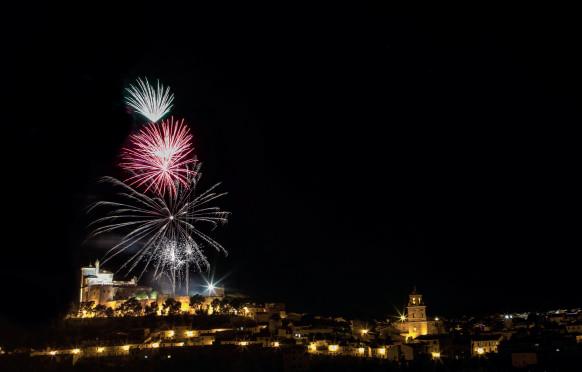
La Feria de Caravaca de la Cruz, que se celebra el tercer fin de semana del mes de octubre, ofrece al visitante exposición y venta de maquinaria agrícola y automoción, contando con un programa de actividades paralelas adaptado a los distintos gustos y edades, como demostraciones, degustaciones y venta de productos gastronómicos, Mercado de Antigüedades, Coleccionismo y Segunda Mano, actividades de animación y música en directo.
Declared to be of International Tourist Interest. The festivities in the name and honour of the “Santísima y Vera Cruz” take place from May 1st to May 5th. They are celebrated in honour to the True and Holy Cross, patron saint of the city. They commemorate events that occurred during the lengthy period when Caravaca shared a border with the Nasrid Emirate of Granada. Ethnologically, they are of great interest, particularly the festivity of the Wine Horses.
On the morning of May 2nd, the appearance of the Holy Relic that happened in 1231 is celebrated. Due to this miraculous appearance, the Moorish governor of the town and all his army forces adopted the Catholic faith. The Mass that commemorates this apparition is traditionally held on the morning of May 2nd in the small shrine called popularly “El Templete”. It is also the only day that the Wine Horses are in the streets. THIS FESTIVAL IS UNIQUE IN THE WORLD AND HAS BEEN DECLARED INTANGIBLE CULTURAL HERITAGE OF HUMANITY BY UNESCO.
At the beginning, the aim of these horses was to bring the wine to the Sanctuary to get it blessed. As time went by, the wineskins were replaced by luxuriously embroidered costumes, genuine works of art. This unique festivity includes two different contests: the race or speed test, and the dressing or way the horses are harnessed competition. The same afternoon, the Moorish Group and the Christian Group simulate a battle to commemorate ancient times. The Holy Cross is taken in a procession from the Basilica-Sanctuary to El Salvador Parish Church.
There are further parades on May 3rd: In the morning, the Children’s Parade and the ponies’ race, where children show their ability to understand the festivity from a young age. In the afternoon, there is a dialogue called “El Parlamento” between the Moorish and the Christian Kings and a new simulated battle, followed by the Bathing of the Cross ceremony to bless the water that irrigates the fields of Caravaca. On May 4th there is a Great Parade along the city’s main road. Finally, May 5th is a day of deep religious feelings, with a multitudinous procession that walk with the Cross towards the Basil-
ica-Sanctuary where it will remain for the rest of the year.
Declared to be of National Tourist Interest. This is held in Barranda, a village in the Caravaca district. An interesting “Quadrilles Festival” or “Festival de Cuadrillas” (traditional local folklore music groups that play and dance typical animeras, pardicas, jotas, manchegas, among other songs and dances) takes place in this village. This festivity was first held in 1979, supported by La Candelaria festivities, Patroness Saint of Barranda. The “Quadrilles” groups, following their ancient incorporation under the wing of the church, performed various rites that are still practised today. Six to fifteen musicians play string and percussion instruments in this group, although some of the quadrilles also play wind instruments. They play pieces for individual and couple dances and Christmas carols.
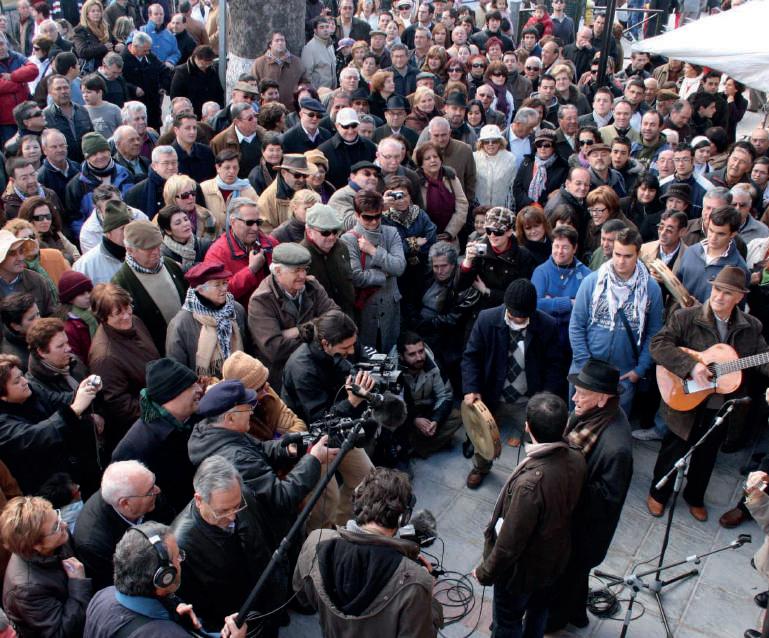
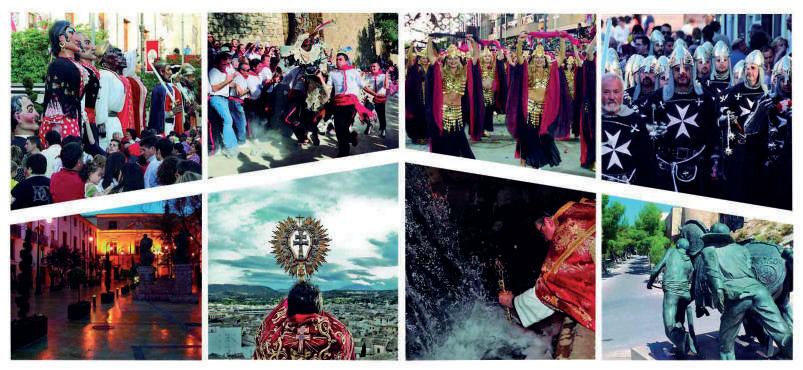
This Festivity is celebrated the last Sunday of January.
This praise is held on September 14th and is a religious festivity. The solemn “Quinario” or “Five-Day Religious Devotion” starts on September 10th with a series of religious acts that take place previously in the Basilica-Sanctuary.
The Fair of Caravaca de la Cruz, which is held on the third weekend of October, offers visitors agricultural machinery and automotive exhibition and trade. The market has a side program of different activities adapted to different wishes and ages, such as exhibitions, Tastings and gastronomic product sales, Antique Collections Market, Collectionism and Second Hand Products. It also has entertainment activities and live music.
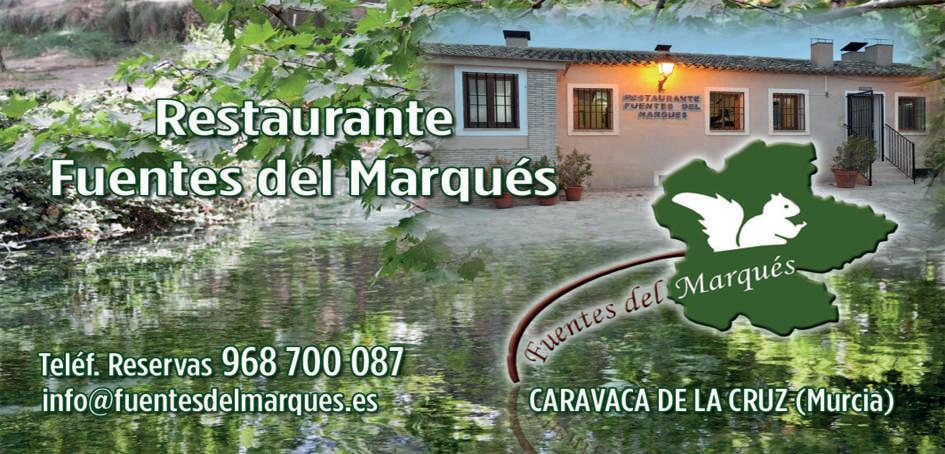
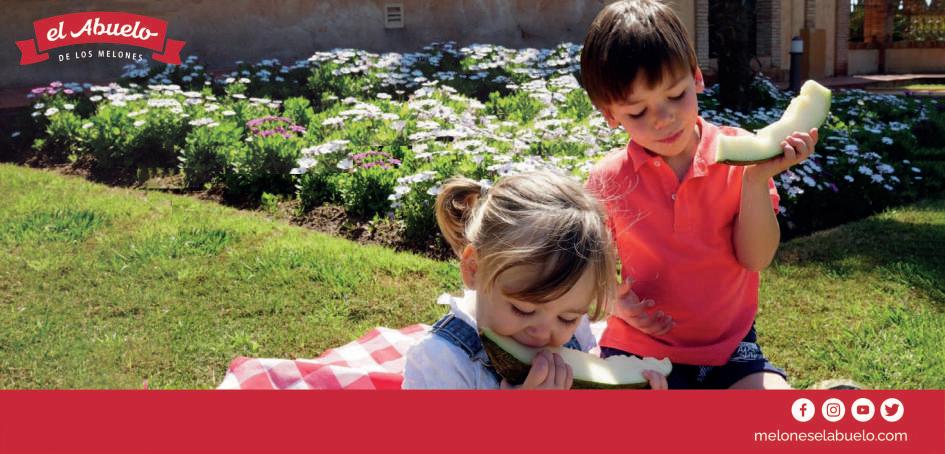
Celebra Caravaca de la Cruz su Semana Santa realizando diversos actos religiosos que rememoran la Pasión, Muerte y Resurrección de Cristo. Son en estas fechas cuando el patrimonio imaginero de las iglesias de la ciudad sale a la calle en las procesiones que organizan las distintas Cofradías de Martes Santo a Viernes Santo.
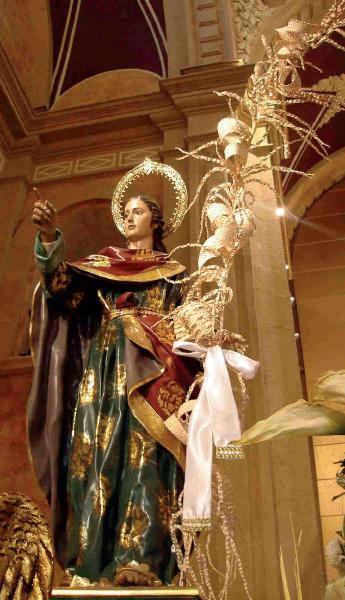

Caravaca de la Cruz celebrates its “Semana Santa” with different acts and processions of Nazarenes with images that recall the Passion, Death and Resurrection of Christ. It is then when the image heritage housed on the churches of the town process into the streets in the religious parades organised by the different Brotherhoods from Easter Tuesday to Good Friday on this Holy Week.
 La Almudema.
La Almudema.
Está situada en el cuadrante S. E. del municipio, en la cuenca del río Quípar, que une la provincia de Murcia a la de Almería. Su nombre parece remontarse a la época musulmana; lo cierto es que en el siglo XV este lugar ya parece conocerse como La Almudema. Dicha pedanía posee una iglesia construida en el año 1769.
Comprende, además del núcleo principal, los caseríos de Casicas y Noguericas, más un conjunto de viviendas diseminadas. Se sitúa en el corredor que se dirige hacia el Campo de San Juan (Moratalla) en la cuenca del río Argos, al oeste de Caravaca. Archivel tiene una iglesia del siglo XVII, aunque recibió sucesivas reformas fundamentalmente en los siglos XVIII y XIX. La economía de Archivel ha sido siempre básicamente agropecuaria.
Se halla en una encrucijada de vías de comunicación siendo la más importante la carretera que se dirige hacia Granada. Consta de los siguientes núcleos de población: Barranda, El Altico, La Cabezuela y la Vereda.
Esta pedanía se sitúa en la cuenca del Argos en su margen derecha. Linda por el Este con la Vega de Caravaca. Benablón ha sido desde la Edad Media jurisdicción del Concejo de Caravaca, salvo en el siglo XIX que pasó a convertirse en diputación del recién creado Ayuntamiento de Archivel.
Se sitúa al S. O. de la vega de Caravaca. Actualmente su población se distribuye en tres zonas: La Encarnación, Arrabal de la Encarnación y en diseminado. El cristianismo hizo pronta aparición en la zona, llegando a la postre a transformar el templo romano, acondicionándolo al culto cristiano.
También de época musulmana existen vestigios, destacando entre ellos la denominada Cueva del Rey Moro. La Encarnación rinde tributo a su Patrona la Virgen de La Encarnación.
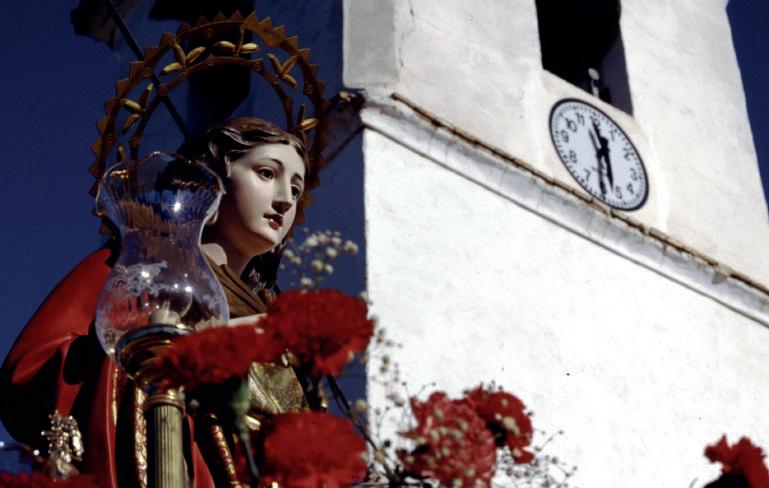
Al Hornico se le conoce en el siglo XVI como el Forno de Arana (Horno de Arana). En cuanto al Tartamudo, su topónimo está ya claramente constituido en el siglo XVI. El Hornico, históricamente adscrito a El Moral, ha estado en todo tiempo sujeta a la jurisdicción de Caravaca, mientras que El Tartamudo pasó a ser diputación de Archivel.
Comprende los caseríos de la Junquera, El Moralejo y la Capellanía, más el conjunto de viviendas dispersas anejas a cada una de ellas.
Abarca los núcleos de Navares de Arriba y Navares de Abajo más los caseríos dispersos. Hay en esta zona un hermoso paraje conocido como la Fuente de Navares.
El núcleo principal de población está en la cuenca del Quípar. Recientemente se le ha dotado del nombre de Pinilla de San José.
En la actualidad abarca solo y exclusivamente los núcleos de Singla de Arriba y Singla de Abajo más un conjunto de viviendas dispersas.
Se encuentra al pie de la Serrata. El nombre de Caneja es conocido desde la Edad Media tal como es hoy. Lo que sí es casi seguro, es su poblamiento en tiempos de los romanos.
El territorio de esta pedanía está muy cerca del antiguo reino de Granada, en el corazón de la frontera medieval entre éste y el de Murcia.
Abarca los territorios de Los Royos de Arriba y Abajo, Retamalejo, Poyos de Celda, Peñicas, Tarragoya, Morales y Campo Coy. Los Royos, núcleo principal de la pedanía, se encuentra a 970 metros de altitud y casi limítrofe con la provincia de Almería.
Está en la cuenca del Quípar, en su margen izquierda, a una altitud de 771 metros. La historia de Los Prados se puede vincular en todos los sentidos a la de La Encarnación, por cuanto sus orígenes son comunes.
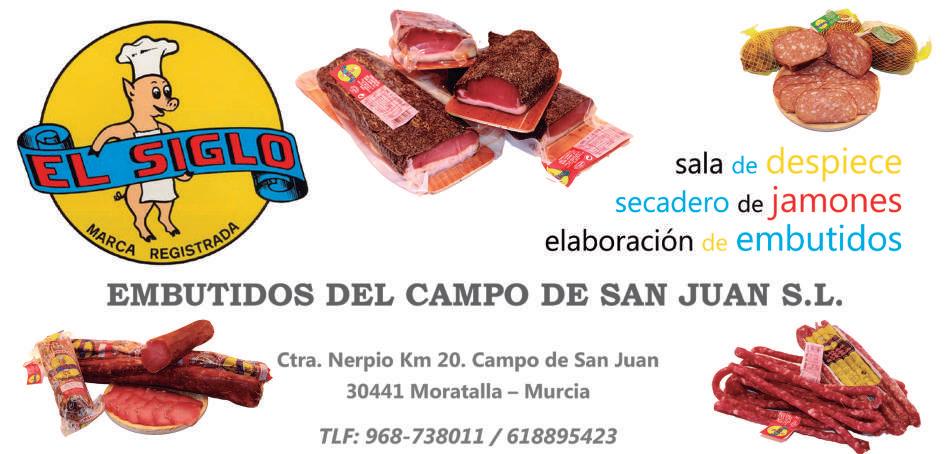

Situated in the southeast sector of the district, in the Quípar River Basin that links the provinces of Murcia and Almería. Its name is believed to date back to the Muslim epoch; it seems that in the 15th century, this area was already known as La Almudema. This village has a church that was built in 1769.
This village includes not only the main town and Casicas hamlet and Noguericas hamlet, but also a complex of outlying dwellings. It is set in the passage that runs to Campo de San Juan (Moratalla) in the Argos River Basin, on the west side of Caravaca. Archivel has a 17th century church, although it was renovated several times in the 18th and 19th centuries. Archivel’s economy has always been based primarily on agriculture.
It is set at a crossroads whose most important way is the one that goes to Granada. It comprises the following areas: Barranda, El Altico, La Cabezuela and La Vereda.
This village lies on the right bank of the Argos River basin. On the east, it borders with the meadow of Caravaca. Since the Middle Ages, Benablón has been under the jurisdiction of the Caravaca Council except in the 19th century, when it became part of the recently created Archivel Town Council.
It is located on the Southwest of the Caravaca meadow. Its population is currently distributed in three areas: La Encarnación, Arrabal de la Encarnación and scattered places. Christianity appeared early in the area, resulting in the transformation of the Roman Temple, preparing it
for Christian worship. There are also some remains of the Muslim period, among them the so-called Cave of the Moorish King (Cueva del Rey Moro). La Encarnación is a name honaoured to their Patronnes, the Encarnación Virgin (La Virgen de la Encarnación).
El Hornico was known in the 16th century as Forno de Arana (Oven of Arana). As for Tartamudo, its name dates from the 16th century. El Hornico, historically ascribed to El Moral, has always been under Caravaca’s jurisdiction whereas El Tartamudo became part of Archivel Council.
La Junquera includes the hamlets of La Junquera, El Moralejo and La Capellanía. Furthermore, It also includes the complex of outlying dwellings belonging to each of them.
It includes the villages of Navares de Arriba (Upper part of Navares Village) and Navares de Abajo (Lower part of Navares village) and the outlying dwellings. This area includes the beautiful setting known as Fuente de Navares.
The town’s centre is in the basin of the Quípar River. It has recently taken the name of Pinilla de San José.
Singla village currently covers only the villages of Singla de Arriba (“Upper Singla”) and Singla de Abajo (“Lower Singla”) and a number of outlying dwellings.
Caneja lies at the lower part of La Serrata mountain. The name of Caneja has been known since the Middle Ages
as it remains today. What is almost sure is that it had a settlement during the Roman period.
The lands of this village are very close to the ancient kingdom of Granada, in the centre of the medieval border between Granada and Murcia.
Los Royos village includes the territories of Los Royos de Arriba (“Upper part”) and Los Royos de Abajo (“Lower
part”), Retamalejo, Poyos de Celda, Peñicas, Tarragoya, Morales and Campo Coy. Los Royos, main centre of the village, lies at 970 metres above sea level in an area close, almost bordering, the boundary of Almería Region.

Situated on the left bank of the Quípar River basin, it lies 771 metres above sea level. The history of Los Prados can be linked totally and in all senses to the one of La Encarnación, as their origins are the same.

Es uno de los grandes atractivos del municipio. Es un Paraje Natural catalogado como Sitio Histórico y situado a 2 km de la localidad. Se puede acceder a él, bien por la Avda. de los Andenes en automóvil, siguiendo el Camino de las Fuentes, o bien siguiendo el Camino del Huerto, si se prefiere ir andando. La finca debe su nombre a los Marqueses de San Mamés y al nacimiento de varios manantiales de agua. Es el agua, y su distribución mediante acequias y canales, la que ha dado lugar a este frondoso y agradable paraje. Existen cuatro importantes nacimientos, dos de ellos acondicionados en forma de «Sartenes».
De interés son también «Las Cuevas del Marqués», que están situadas sobre una colina que domina Las Fuentes.
Además, en el lugar podemos encontrar el «Albergue Juvenil» con capacidad para 44 personas y desde donde se propician actividades varias como rutas monumentales, paisajísticas y gastronómicas, senderismo, conocimiento del medio natural (se encuentra junto al Centro de Interpretación de la Naturaleza), conferencias, exposiciones, etc. que constituyen un complejo fundamental para este magnífico paraje.
«El Centro de Interpretación de la Naturaleza» o «Centro de Visitantes» está ubicado en el llamado «Torreón de los Templarios», resto histórico-artístico situado en la entrada del paseo principal de «Las Fuentes del Marqués».
Literally the “Springs of the Marquis”, this park is one of the town’s great attractions. It is a Natural Park classified as an historic site, two kilometres away from the city. You can get to the park from Avenida de los Andenes (along Camino de Mayrena by car, or along Camino del Huerto if you prefer to go walking). The area owes its name to San Mamés Marquises (Marqueses de San Mamés) and the several springs of water that exist there. The water and its distribution through ditches and channels created this pleasant green area. There are four main springs; two of them are round-shaped with the form of a “pan”.
Las Cuevas del Marqués (literally “The Caves of the Marquis”) are situated on the top of a hill overlooking “Las Fuentes” and are also very interesting. Here we can also find the Youth Hostel which can accommodate 44 people
and from where a variety of activities are organised, such as sightseeing, monumental, landscape and gastronomic routes, trekking, nature knowledge and awareness studies (next to the Nature Interpretation Centre), conferences, exhibitions, among others, which form a fundamental complex for this magnificent setting.
The Nature Interpretation Centre or Visitors Centre is situated on the Templar Fortified Tower, an historic and artistic remain located at the beginning of the main promenade of this natural place.
To access it on weekends and holidays, a prior reservation is essential at: https://www.lasfuentesdelmarques. com, a website where you can find out the rules of the area itself in order to continue enjoying this beautiful natural environment.
Fuentes del Marqués.
Para acceder al mismo en fines de semana y festivos es imprescindible la reserva previa en: https://www.lasfuentesdelmarques.com, página web en la que podrán conocer las normas del propio paraje para poder seguir disfrutando de este bello entorno natural.
Fuentes del Marqués.

La Vía Verde del Noroeste constituye uno de los corredores ecológicos más importantes de la Región de Murcia, vertebrando la misma y convirtiendo este camino en un recurso turístico de primer orden.
Aprovechando el antiguo trazado ferroviario entre Murcia y Caravaca de la Cruz, durante su recorrido se suceden paisajes de gran belleza y variedad característicos del patrimonio natural y cultural de la Región de Murcia,
en el que se incluyen tres espacios naturales en la Red Natura 2000 y numerosos lugares catalogados Bien de Interés Cultural (BIC). Es un recorrido de 78 km de camino natural que atraviesa 9 municipios murcianos: Murcia,
Molina de Segura, Alguazas, Campos del Río, Albudeite, Mula, Bullas, Cehegín y Caravaca de la Cruz.
Por la Vía Verde del Noroeste, además, transcurre el Camino de la Cruz (Camino del Levante).
The Natural Rail Trail of the Northwest area of the Region of Murcia, known as the “Vía Verde del Noroeste” is a green pathway that constitutes one of the most important ecological corridors of the Region of Murcia, crossing part of the province and turning this way into

a very important tourist resource.
The trail takes advantage of the former railway traced between Murcia and Caravaca de la Cruz, and during the way we can admire really beautiful and different landscapes that are typical from the natural and cultural her-
itage of the Region of Murcia, where three natural spaces inside of the Natura 2000 Network and numerous places declared to be of Cultural Interest (Spanish BIC) are included.
It has 78 kilometres of natural way that crosses 9 cities of the province:
Murcia, Molina de Segura, Alguazas, Campos del Río, Albudeite, Mula, Bullas, Cehegín and Caravaca de la Cruz.
Along the Natural Trail, in addition, it is overlapped the the Way of the Cross (“Camino de la Cruz”) or “Levant Way” (“Camino del Levante”).
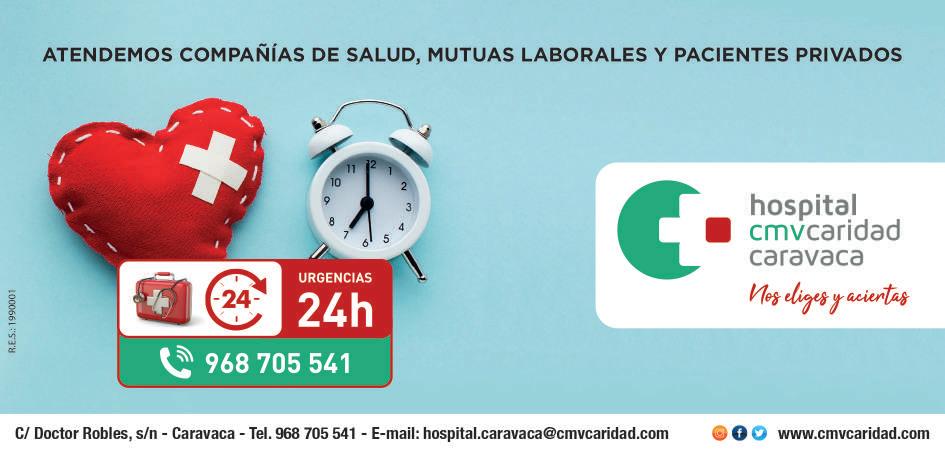
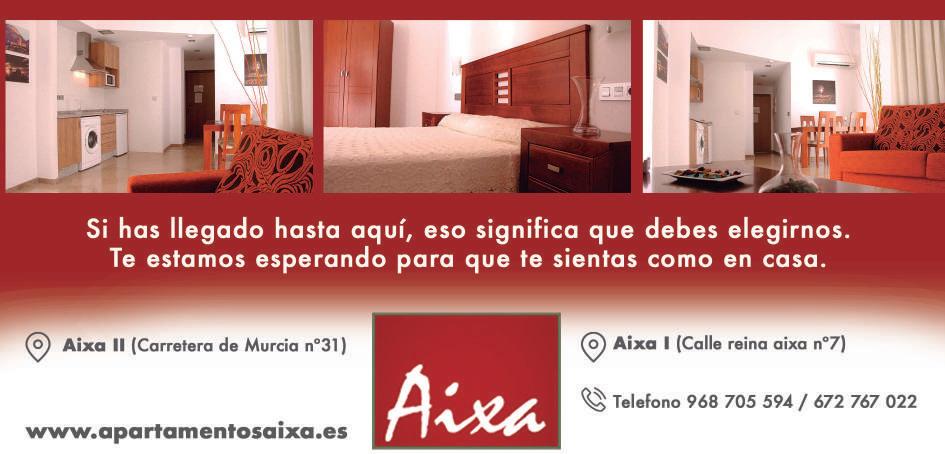
El Camino de Levante, con un total de 118 km, tiene su inicio en la localidad alicantina de Orihuela, suponiendo un importante camino de peregrinación que añade un incentivo turístico más para todos los peregrinos y visitantes que quieran acudir a nuestra ciudad con motivo de los Años Jubilares, bien sea a pie o en bicicleta.
La importancia de esta ruta radica en que aúna en un mismo producto toda una serie de atractivos que refuerzan el turismo de la Región de Murcia en varios ámbitos como son el turismo religioso, turismo cultural, turismo rural, turismo activo, etc.
El Camino de la Vera Cruz es un reco-
rrido para peregrinos que parte desde Roscenvalles-Puente la Reina para llegar hasta Caravaca de la Cruz, donde se venera la sagrada reliquia de la Cruz en la que Jesucristo fue crucificado, según la religión Católica
El recorrido atraviesa Navarra, transcurre por Aragón, Valencia y Castilla-La Mancha, hasta llegar a la Región de Murcia. Son casi 900 kilómetros que hoy han sido recuperados y puestos en valor para atraer a los peregrinos que desean rendir culto, por su devoción, a la Santísima y Vera Cruz de Caravaca.
Camino de San Juan de la Cruz
Hoy día se encuentra acondicionado el Camino de San Juan de la Cruz desde Caravaca a Beas de Segura, no
siendo este un camino unidireccional, se recorre en un sentido u otro, y el destino lo elige quien lo transita.
Dividido en cinco etapas, con un trayecto de 151 Kilómetros, es un camino de gran valor y riqueza que recorre la Sierra de Segura por tierras de Jaén, Albacete y Murcia, en su mayor parte por los antiguos dominios de la Encomienda de Segura de la Orden de Santiago, pasando por todos los parajes por los que anduvo San Juan de la Cruz a finales del siglo XVI, un camino hacia el interior siguiendo los pasos del Padre de la mística, universalmente reconocido. La persona valora y vive el camino en un mismo caminar, lo importante no es llegar a un sitio u otro, sino recorrer los mismos paisajes que a él le inspiraron.
Una nueva vía de peregrinación en el que han aunado esfuerzos el ayuntamiento de Caravaca de la Cruz y el de Vélez Blanco, es el “Camino Real de los Vélez’, de unos 70 kilómetros, y que da inicio en el municipio almeriense abarcando territorio de las comunidades autónomas de Andalucía y Murcia.
El trayecto está dividido en cuatro etapas en el que el caminante o ciclista tendrá la oportunidad de disfrutar de forma tranquila de la naturaleza, pues encontrará zonas de pinar, cultivos extensivos de secano, ramblas, aldeas y cortijos.
The Camino de Levante, with a total of 118 km, has its beginning in the city of Orihuela, in Alicante, assuming an important pilgrimage route that adds an additional tourist incentive for all pilgrims and visitors who want to go to our city on the occasion of the Jubilee Years, either on foot or by bicycle.
The importance of this route is that it combines in the same product a whole series of attractions that reinforce the tourism of the Region of Murcia in several areas such as religious tourism, cultural tourism, rural
tourism, active tourism, etc.
The Camino de la Vera Cruz is a route for pilgrims that starts from Roscenvalles--Puente la Reina to reach Caravaca de la Cruz, where the sacred relic of the Cross on which Jesus Christ was crucified is venerated, according to the Catholic religion.
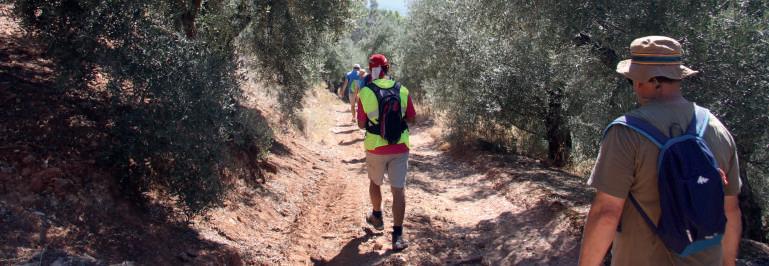
The route crosses Navarra, passes through Aragon, Valencia and Castilla-La Mancha, until it reaches the Region of Murcia. There are almost 900 kilometers that today have
been recovered and valued to attract pilgrims who wish to worship, for their devotion, the Santisima y Vera Cruz de Caravaca.
Camino de San Juan de la Cruz
Today, the Camino de San Juan de la Cruz is conditioned from Caravaca to Beas de Segura, not being a unidirectional road, it is registered in one direction or another and the destination is chosen by the person who travels it.
Divided into five stages, with a journey of 151 kilometers, it is a road of great value and richness that records
the Sierra de Segura through lands of Jaén, Albacete and Murcia, mostly by the former domains of the Encomienda de Segura de la Order of Santiago, passing through all the places through which San Juan de la Cruz walked at the end of the 16th century, a path inland following in the footsteps of the Father of mysticism, universally recognized. The person values and lives the way in the same walk, the important thing is not to get to one place or another, but to travel the same landscapes that inspired him.
A new pilgrimage route in which the town hall of Caravaca de la Cruz and that of Vélez Blanco have joined forces, is the “Camino Real de los Vélez”, about 70 kilometers, and which begins in the municipality of Almeria, covering territory of the autonomous communities of Andalucia and Murcia.
The route is divided into four stages in which the hiker or cyclist will have the opportunity to enjoy nature in a quiet way, as you will find areas of pinewood, extensive dryland crops, ramblas, villages and farmhouses.
La Gastronomía de Caravaca de la Cruz, de alta calidad, está ligada a los productos agrícolas y ganaderos de la zona. Así, las migas, los arroces en todas sus variantes: con conejo, pollo, garbanzos, caracoles, níscalos, bacalao... (tener en cuenta la proximidad de Calasparra, cuyo arroz tiene Denominación de Origen), son menús muy solicitados en esta zona. Destacan asimismo la carne de cordero en tartera y a la brasa (el cordero

segureño, –cordero de esta zona–está catalogado con la denominación I. G. P. (Indicación Geográfica Protegida), los embutidos de cerdo, los potajes (de espinacas, apio, etc.), y, sobre todo, la repostería, en la que destacan las yemas y el alfajor (dulce típico navideño de la Comarca), así como los licores de elaboración casera como la mistela y el licor café, constituyen una carta rica y variada que hace las delicias de todos los que nos visitan.

Caravaca de la Cruz high-quality gastronomy is linked to the local agricultural and livestock production. It includes migas (fried breadcrumbs with meat and vegetables) and all sorts of rice dishes or paellas: with rabbit, chicken, chickpeas, snails, saffron milk-cap mushrooms, cod, among others. Calasparra, whose rice has a Designation of Origin or record of provenance, is very close to our city. These dishes are highly sought after in the area.
“Cordero en tartera” (roast lamb, potatoes and vegetables) and “cordero a la brasa” (charcoal-grilled lamb)
are underlined dishes of Caravaca de la Cruz district as well as “cordero segureño” or local mountain lamb (classified with the designation PGI, or Protected Geographic Indication), “embutido” (usually cold pork sausages), stews (spinach, celery, etc.) and, over all, pastries or desserts, like delicious “yemas” (sweet yolks covered with chocolate or caramel sauce) and “alfajor” (a typical local Christmas almond pastry sweet) and homemade liqueurs like “mistela” (grape juice liquor with alcohol) and “licor café” (coffee liqueur), constituting a rich and varied menu that delight all visitors.
** HOTEL EL ZORRO
Paraje La Loma, s/n (Barranda). T. 968 43 31 40 / 968 72 52 89 www.hotelzorro.com
** HOTEL MALENA
Pol. Industrial Cavila. Ctra. de Granada. T. 968 72 52 62 / 680 46 15 81
* HOTEL EL MOLINO DEL RÍO
Camino Viejo de Archivel, s/n. (Benablón). T. 692 65 48 04 / 968 43 33 81 www.molinodelrio.com
* HOTEL ALMUNIA
Ingeniero Oñate, 3-5. T. 968 70 57 37 www.hotelruralmurcia.com
* HOTEL LA VERA CRUZ Domingo Moreno, 9. T. 868 78 46 06 / 626 63 74 95 www.hotellaveracruz.com
* HOTEL CONVENTO NTRA. SEÑORA DEL CARMEN. Corredera, 7. T. 968 70 85 27 www.hospederiacaravaca.org
CÍRCULO ARTÍSTICO 1911. HOTEL BOUTIQUE Mayor, 5. T. 968 70 24 22 / 625 29 39 50 www.monumentohotelboutique.com
ALBERGUE DE PEREGRINOS “LA ESTACIÓN” T. 722 44 06 44
APARTAMENTOS TURÍSTICOS TOURIST APPARTMENTS
APARTAMENTOS AIXA 1 y 2. Ctra. de Murcia, 31. Reina Aixa, 7. T. 968 70 55 94 www.apartamentosaixa.es
APARTAMENTOS CUESTA DE LA CRUZ. T. 680 74 15 71 www.cuestadelacruz.com
APARTAMENTOS DON ÁLVARO. Cuesta Don Álvaro, 9. T. 696 97 76 67 / 647 91 62 22 www.alojamientosdonalvarocaravaca.com
LA CASA DEL BALCÓN. C/ Mayor, 28. T. 968 72 40 54 www.lacasadelbalcon.com
APARTAMENTOS TEMPLETE. Plaza del Templete. T. 630 06 67 66 www.apartamentostemplete.com
ALOJAMIENTOS RURALES RURAL ACCOMMODATION
CASA AMAPOLA (HUERTA) T. 968 70 03 52
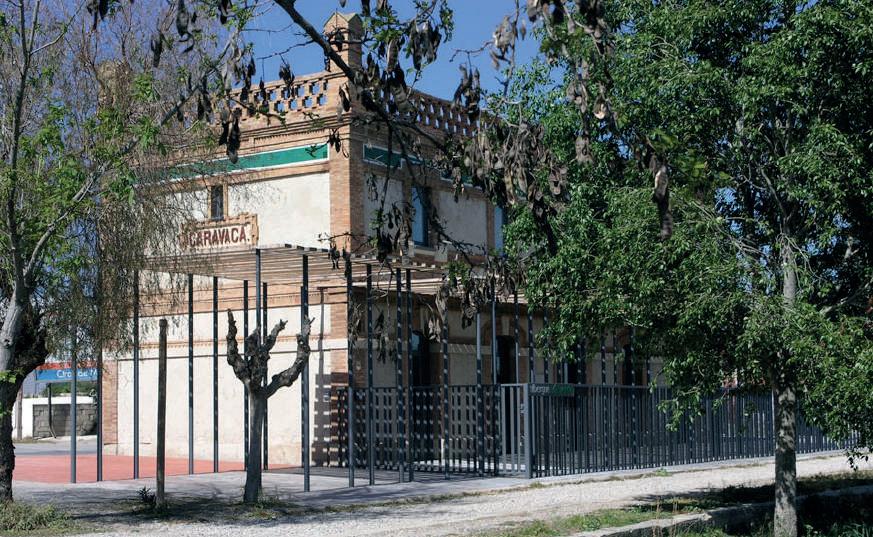
CASA BALAZOTE (BARRANDA) T. 609 52 15 30
CASA BEGOÑA (HUERTA) T. 968 70 03 52
CASA CARMELA (HUERTA) T. 968 70 03 52
CASA CUESTA DE LA MONJAS (CASCO URBANO) T. 622399970 / 620300863
CASA CHIRREAS (BENABLÓN) T. 628948828
CASA DE PEDRO (LOS ROYOS) T. 617 66 05 34
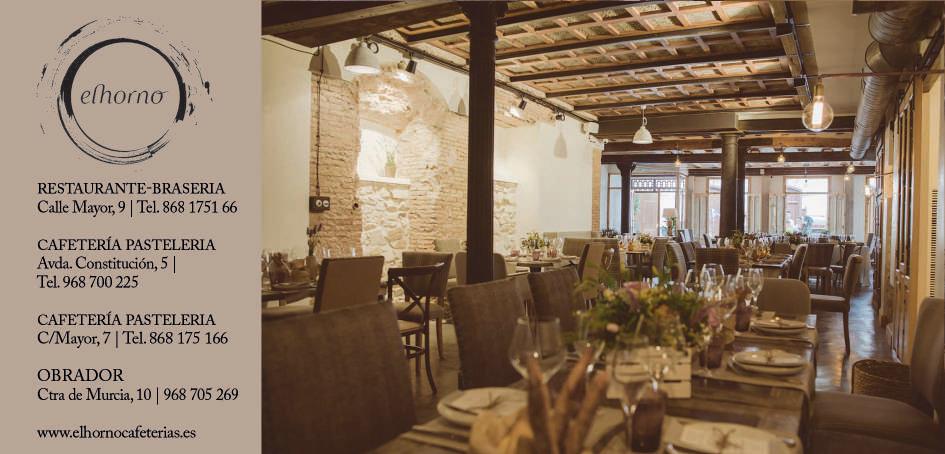
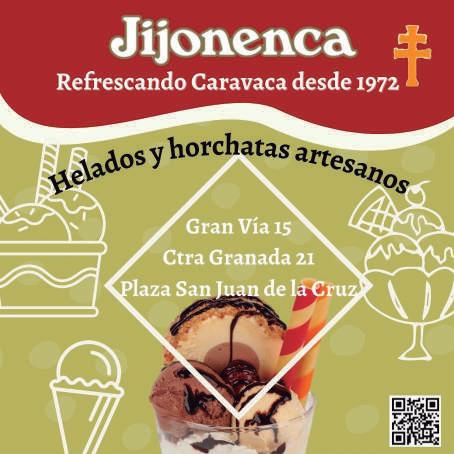
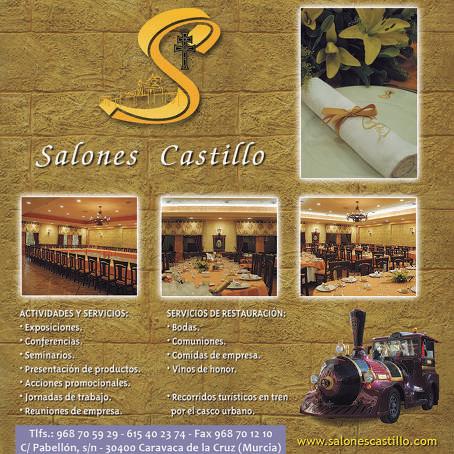
CASA DULCE (ARCHIVEL)
T. 676 52 02 94
CASA HONDA (BARRANDA)
T. 968 70 22 17
CASA LA MORERA (HUERTA) T. 968 70 03 52
CASA LA TINAJA (HUERTA) T. 968 70 03 52
CASA MARÍA (HUERTA) T. 968 70 03 52
CASA NOGUERICAS I-II-III
T. 652 52 55 63
CASA REINA I-II
CAMPO DE ARRIBA (ARCHIVEL)
T. 650 03 63 40
CASA RUIZ I-II-III Y IV (ARCHIVEL)
T. 635 42 13 75
CASA RULERO (LOS ROYOS) T. 629 05 75 69
CASERÍO PEÑA RUBIA (MONTAÑA CARAVACA)
T. 690 11 10 79
CORTIJO TARTAMUDO DE ABAJO (EL MORAL)
T. 652 52 55 63
DON IGNACIO (PINILLA)
T. 968 70 39 68
LA ESCUELA (HUERTA)
T. 619 65 55 47
LA JIMENA (LOS PRADOS) T. 650 614724
LAS MINAS (HUERTA) T. 968 70 31 78
LAS OICAS (ARCHIVEL) T. 685 05 22 93
MOLINO DE GUARINOS (BARRANDA) T. 968 70 20 89
PANTANERO (LOS PRADOS) T. 968 70 40 57
PARAJE DE LAS FUENTES (HUERTA) T. 968 70 30 98
PEÑA MARÍA (CASCO URBANO) T. 968 70 85 70
RAMBLA DE LA HIGUERA (ARCHIVEL) T. 649 55 83 87
SIERRA MOJANTES (ARCHIVEL) T. 679 47 78 00
VILLA ROSA (NAVARES) T. 968 70 87 63
VILLA TRINIDAD (NAVARES) T. 606 73 96 01
VUELTA DEL CARRIL (BARRANDA) T. 968 70 33 24
Detalle del Monumento al Moro y al Cristiano de Rafael Pi. Moro.
TELÉFONOS DE INTERÉS USEFUL TELEPHONE NUMBERS
Monumento a San Juan de la Cruz. Rafael Pi.


ALAMEDA
Ctra. de Caravaca, 44, km 24. Pedanía de Barranda. T. 968 72 50 28
ALDO RESTAURANTE Cartagena, 6. T. 968 722 353
ARCE
Salón Supremo, s/n. T. 693 59 92 09
CAPRICHO
Av. Miguel Espinosa, 16. T. 652 29 87 60
CHITA Pl. Constitución, 3. Archivel. T. 968 72 53 19
CASA DEL ABUELO Fco. Martínez Mirete, 7. T. 686 50 33 31
CLUB HÍPICO
Rincón de Guitarra. T. 663 50 73 81
D’GUSTA Balazote, 6. T. 647 85 70 70
DEMS FJ Ctra. de Granada, 15 bajo. T. 610 39 87 93 / 868 17 51 38
ATENEO Pl. del Arco, 5. T. 618 37 56 79
EL CASÓN DE LOS REYES
Ctra. de Granada, 11. T. 968 72 22 47 / 664 29 84 03
EL HOSPITAL
Av. Miguel Espinosa. T. 968 70 30 58
EL MOLINO DEL RÍO (HOSPEDERÍA RURAL)
Camino Viejo de Archivel, s/n
(Benablón).
T. 968 43 33 81 / 692 65 48 04
EL ZORRO
Ctra. de Granada. Pedanía de Barranda. T. 968 72 52 89
FELYMAR GASTROTECA
Plaza Tuzla, antigua plaza de abastos. T. 666 06 56 97
FUENTES DEL MARQUÉS
Paraje Fuentes del Marqués. T. 968 70 00 87 / 695 38 56 15
GASOLINERA ALMUDEMA BAR (La Almudema)
T. 968 70 41 40 / 649 41 72 40
GRAN RUTA
Pedanía de El Moral. T. 968 72 51 47
HONG-KONG Gran Vía, 46. T. 968 70 02 66
KEBAB SILAN Gran Vía, 31. T. 968 70 06 34
KENTO GASTRO SUSHI Plaza Tuzla, antigua plaza de abastos. T. 868 17 51 98
LA BODEGA Pl. del Arco, 4. T. 659 66 14 71/ 635 50 94 79
LA COMPAÑÍA GASTROBAR Mayor, 43. T. 968 70 30 52
LA DESPENSA DEL PEREGRINO Mayor, 13. T. 868 18 50 63
LA HERRADURA Pizarro, 18. T. 968 70 50 33 / 968 70 50 53
LA TRAVIATTA Pl. Hermanos Pinzón. T. 660 46 68 47
LAS DELICIAS DEL HORNO Mayor, 9. T. 868 17 51 66
LOS GEMELOS Ciudad Jardín, 7. T. 968 70 87 35
L’ BRASSA Av. Juan Carlos I, 39. T. 633 76 61 15
MALENA Polígono Industrial. Ctra. de Granada. T. 968 72 52 62
MOLIÉRE RESTO-BAR Avda. de la Constitución, 23 T. 868 18 51 57 / 636 58 23 81
EL PROGRESO Plaza Nueva, 2. T. 697 70 63 94 PALADAR San Simón, 3. T. 968 70 58 29 / 663 01 41 70
Ermita de la Reja.
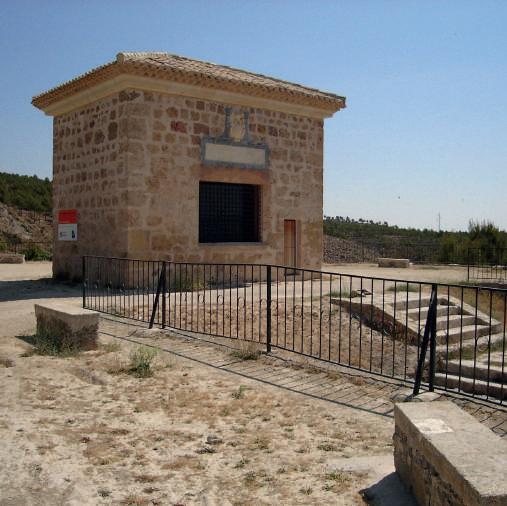
PEDRO MARÍN Raimundo Rodríguez 3. T. 667 69 06 75
PIZZERÍA CAPRY Puente Molino, 3 bajo. T. 968 70 88 30
PLAZA Pl. Constitución, 5. Archivel. T. 968 72 86 44
PLAZA MASSIMA (GOOD FOOD & GALLERY) Gran Vía, 18. T. 968 70 20 90
POLIDEPORTIVO ARGOS Cno. Viejo de Archivel. T. 679 53 16 01 / 682 87 04 04
POLIDEPORTIVO LA LOMA Extremadura, s/n. T. 642 00 95 01
PORTÓN DE LA COMPAÑÍA C/ Mayor, 38-bajo. T. 618 66 03 23
RESTAURANTE AIXA Ctra. Murcia, 31. T. 654 84 10 25
RINCÓN DE FACUNDO Pl. Hermanos Pinzón, 2. T. 619 92 45 04
RINCÓN DE PACO Lonja, 5. T. 968 70 83 90
SALÓN DE CELEBRACIONES JARDINES DEL SOL
T. 968 70 30 63 /696 69 50 79
SALÓN-RTE. PEDRO MARÍN Paraje Santa Inés. T. 667 69 06 75
SALÓN DE CELEBRACIONES CRISTI
Ctra. de Murcia, Km 2. T. 660 55 15 18
SALONES CASTILLO Pabellón, s/n. T. 968 70 59 29 / 615 40 23 74
TERE Severo Ochoa, 20. T. 650 94 30 92
VENTA CAVILA
Ctra. de Granada, cruce de Lorca. T. 968 72 52 12
BARES / CAFETERÍAS BARS /
AROMA CAFÉ
Av. Juan Carlos I, 9. T. 640 67 86 70
ARTESANO
Ctra. de Granada, 2. T. 692 30 89 99
ALBERGUE LA ESTACIÓN Cmno. de la Estación. T. 722 44 06 44
BAR 33 Pilar, 15. T. 968 70 27 19/ 660 16 79 25
BENDITA LOCURA COFFE & DREAMS
Avda. Maruja Garrido, 2. T. 603 40 21 06
BOCATTA’S
Av. Miguel Espinosa, 24. T. 643 38 75 61
BODEGÓN ISI
Pocico, 2. T. 626 64 80 43
BURGUER CJ. Tres Cero C/ Castilla, 2-bajo T. 693 04 43 34
CAFÉ & OLÉ
Cartagena, 1. T. 663 79 34 93
CAFETERÍA CERVANTES
Av. de los Andenes, 10. T. 968 70 23 06
CAFETERÍA PLAZA
Gran Vía, 18. T. 968 70 54 06
CAFETERÍA ROMA
Av. de la Constitución, 88. T. 649 54 92 57
CARAVACA KEBAB HOUSE Av. Constitución, 9. T. 926 04 69 76
CHURRERIA INMA
Avda. Miguel Espinosa,16 T. 868 08 11 10
CHURRERÍA MARÍA JOSÉ
Av. Miguel Espinosa, 10. T. 868 18 51 93
CHACHI PARK PEQUESUEÑOS
Juan Carlos I. T. 671 70 24 58
CONTAMOS CONTIGO Dos de Mayo, 8. T. 626 49 16 25
DELICIAS KEBAB Ctra. Granada, 15. T. 603 66 48 71 / 631 96 86 94
DULCINEA Gran Vía, 19 T. 652 03 09 40
EL BURLADERO Pl. José Carrilero, 2. T. 608 92 28 48
EL EDÉN Gran Vía, 17. T. 659 276 790
EL HORNO CAFETERÍA Mayor, 7 / Av. Constitución, 5. T. 868 17 51 66
EL JARDÍN Av. de los Andenes, 25. T. 968 70 51 81
EL PARQUE Av. Almería. T. 968 70 10 75

EL PATIO DE MI CASA C/ Salón Terraza, 4-bajo T. 686 557 467
EL PENÚLTIMO Pl. Ciudad Jardín, 7. T. 673 79 09 86
GRADA 0 SPORT CAFÉ T. 607 95 89 12
HOGAR DEL PENSIONISTA Av. Juan Carlos I, 17. T. 968 70 28 16
LA CAMPANA Gran Vía, 45. T. 968 70 38 53
LA FUENTE Av. Miguel Espinosa, 4. T. 659 83 18 90
LA JIJONENCA Gran Vía, 15. T. 620 83 74 52
LA MAESTRANZA Pl. Tuzla, 3. T. 968 70 54 92
LA MOCHUELA Gregorio Javier, s/n. T. 686 74 43 39
LAS SIRENAS Juan Carlos I, 20. T. 968 70 33 23
LA TASCA DE ENFRENTE Avda. Miguel Espinosa, 14. T. 682 79 76 53
LOS PAJARITOS Pl. Nueva, 14 bajo. T. 968 70 28 04
LOS VALENCIANÍSIMOS Gran Vía, 57. T. 868 18 54 51
MONTOYA C/ Castilla, nº 4. T. 689 54 92 57
PARADA Gran vía, 53. T. 609 29 09 21
PASARÁ CAFÉ Plaza Hermanos Pinzón, 1 T. 605864838
WONKAS, SB
Gran Vía 5. T. 679 551 438
TELEPIZZA Cervantes, 2, bajo. T. 968 72 21 54
UNAI C/ Almazaríca, 4-6. T. 628 62 79 70
VÍA VERDE Ctra. de Murcia, 45. T. 642 85 32 53
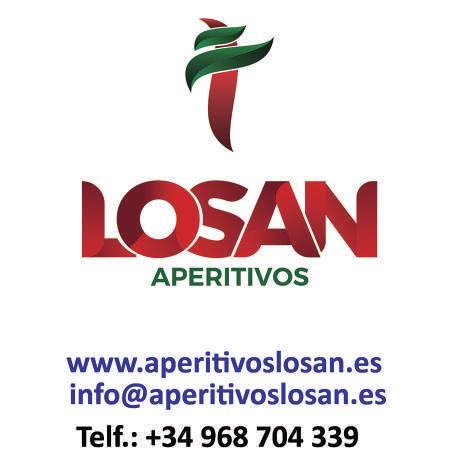


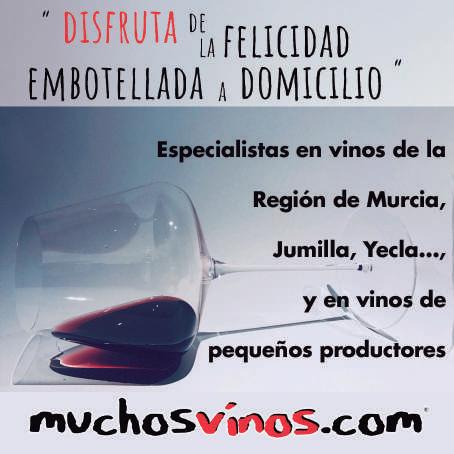
- AMBULANCIAS DE LA REGIÓN DE MURCIA
T. 968 70 79 33
- CENTRO DE SALUD T. 968 70 24 12
- CLÍNICA VIRGEN DE LA CARIDAD CVM T. 968 70 12 06 / 968 70 04 70

- CLÍNICA CARAVACA T. 968 70 39 04
- CRUZ ROJA T. 968 72 22 14
- FARMACIA CAPARRÓS BRAVO T. 968 70 80 96
- FARMACIA GUERRERO QUADRADO T. 968 70 23 89
- FARMACIA LÓPEZ BATTU T. 968 70 83 17
- FARMACIA LÓPEZ SALUEÑA T. 968 70 84 12
- FARMACIA MELGARES CARRASCO T. 968 70 57 74
- FARMACIA SÁEZ MESTRE T. 968 70 84 59
- FARMACIA GINÉS SÁNCHEZ GARCÍA T. 868 08 82 74
- HOSPITAL VIRGEN DE LA CARIDAD T. 968 70 55 41
- HOSPITAL COMARCAL DEL NOROESTE T. 968 70 91 00
- PLANIFICACIÓN FAMILIAR T. 968 70 86 22
- SALUD MENTAL T. 968 70 83 22
- TELÉFONO EMERGENCIA MÉDICA T. 112
- URGENCIAS S.S. HOSPITAL T. 968 70 91 00
- AGENCIA TRIBUTARIA. DELEGACIÓN CARAVACA DE LA CRUZ T. 900 878 830
- ALQUILER DE COCHES LOUIS REN’T A CAR T. 868 78 46 16
- APCOM www.apcom.es
T. 968 70 28 23
- AULA ABIERTA DE INTERNET T. 968 70 87 93
- AYUNTAMIENTO Centralita. T. 968 70 20 00
- BIBLIOTECA MUNICIPAL T. 968 70 56 82
- MUSEOS CARAVACA Reservas: reservas@caravacadelacruz.es T. 968 70 56 20
- CASA DE CULTURA “EMILIO SÁEZ” T. 968 70 56 82
- CENTRO DE EMPLEO, FORMACIÓN E IGUALDAD T. 968 70 11 00
- CENTRO DE RECURSOS JUVENILES Y DE EMPLEO PARA JÓVENES
T. 968 70 84 00
- CENTRO DE SERVICIOS SOCIALES T. 968 70 30 62
- CENTRO DE VISITANTES “TORREÓN DE LOS TEMPLARIOS” T. 968 70 56 20
- COFRADÍA DE LA STMA. Y VERA CRUZ T. 968 70 75 28 - 968 70 85 40
- CONCEJALÍA DE DEPORTES T. 968 70 35 63
- CONSERVATORIO PROFESIONAL DE MÚSICA. LEANDRO MARTÍNEZ ROMERO T. 968 70 01 00
- CORREOS Y TELÉGRAFOS T. 968 70 78 62
- ECOJARDÍN T. 968 70 75 07
- EMISORA MUNICIPAL “CARAVACA RADIO” T. 968 70 24 28 / 968 70 56 85
- ESCUELA DE ADULTOS T. 968 70 25 26
- ESCUELA DE IDIOMAS T. 968 70 02 22
- ESTACIÓN DE AUTOBUSES
T. 699 91 75 18
- GUARDIA CIVI T. 968 70 56 66
- IBERDROLA. Punto de atención al cliente T. 968 70 84 36
- ENTORNO URBANO Servicio de Basuras. Recogida de enseres. T. 968 70 54 96
I. T. V. Polígono Venta Cavila T. 968 72 55 02
I. T. V. La Cayetana T. 968 47 61 10
I. T. V. Rotonda de la Cruz
T. 968 10 00 25
I. T. V. Noroeste T. 868 78 46 46
- MUSEO ARQUEOLÓGICO LA SOLEDAD T. 968 70 05 12
- MUSEO CARRILERO T. 968 70 56 20
- MUSEO DE LA VERA CRUZ T. 968 70 56 20
- MUSEO DE LA FIESTA T. 968 70 56 20
- MUSEO DE LOS CABALLOS DEL VINO T. 868 18 50 96
- MUSEO DE LA MÚSICA ÉTNICA DE BARRANDA (COLECCIÓN CARLOS BLANCO FADOL) T. 968 73 84 91
- NOTARÍA MIGUEL GONZÁLEZ CUADRADO T. 968 70 84 52
- NOTARIA PRESENTACIÓN CASTILLA ALCALÁ
T. 968 70 32 25
- OFICINA COMARCAL AGRARIA T. 968 70 76 66
- OFICINA DE DESARROLLO LOCAL T. 968 70 11 00
OFICINA DE INDUSTRIA T. 968 70 53 67
- OFICINA DE PARTICIPACIÓN CIUDADANA Y TRANSPARENCIA T. 968 70 20 00 Ext. 1020
OFICINA DE TURISMO T. 968 70 24 24
- O. M. I. C. T. 968 70 84 57
- PABELLÓN POLIDEPORTIVO JORGE BERA T. 968 70 35 63
- PABELLÓN POLIDEPORTIVO JUAN ANTONIO CORBALÁN T. 968 70 35 63
- CENTRO DEPORTIVO CARAVACA Juegos Olímpicos, s/n. T. 968 70 54 84
- PALACIO DE JUSTICIA T. 968 70 84 29
- PARQUE DE BOMBEROS T. 968 70 20 30
- PERIÓDICO EL NOROESTE T. 968 70 09 58 / 968 70 13 10
- PISCINA MUNICIPAL DE VERANO Ctra. de Granada. T. 968 70 35 63
- PISTAS POLIDEPORTIVAS JUAN CARLOS I
T. 968 70 03 00
- POLICÍA LOCAL T. 968 70 20 01
- PROTECCIÓN CIVIL T. 968 92 26 32
- REGISTRO DE LA PROPIEDAD T. 968 70 83 51
- SANTUARIO DE LA STMA. Y VERA CRUZ T. 968 70 77 43
- SERVICIO DE AGUAS. AQUALIA T. 902 13 60 13
- SERVICIO REGIONAL DE EMPLEO Y FORMACIÓN (SEF) T. 968 70 84 44
- TAXI ANDREU. 24 H T. 622 93 65 24
- TAXIS Y GRÚAS HIDALGO. 24 H T. 630 97 47 33
- TAXI JOSE Mª HIDALGO. 24 H T. 609 68 25 90
- TAXIS Y GRÚAS MORENO. 24 H T. 646 22 30 09
- TAXIS JOSÉ MARTÍNEZ. 24 H T. 679 86 93 67
- TAXIS JOSÉ MUÑOZ SÁNCHEZ T. 608 07 16 31
- TAXI JOSEFA MARTINEZ ASTURIANO T. 679 86 93 67
- TELECARAVACA T. 968 95 37 03
- U. N. E. D. T. 968 70 02 00
- VALENTIN TRAVEL Avda. de la Constitución, 15. T. 968 95 37 21
- VIAJES AIXA T. 968 70 72 33 / 676 95 70 10
- VIAJES COCOKAY T. 968 72 21 37
- VIAJES EL DESVÁN DEL VIAJERO T. 968 47 90 80 / 637 77 92 38
- VIAJES D’ TOURING T. 968 95 37 10
Edita:
Producción editorial:

